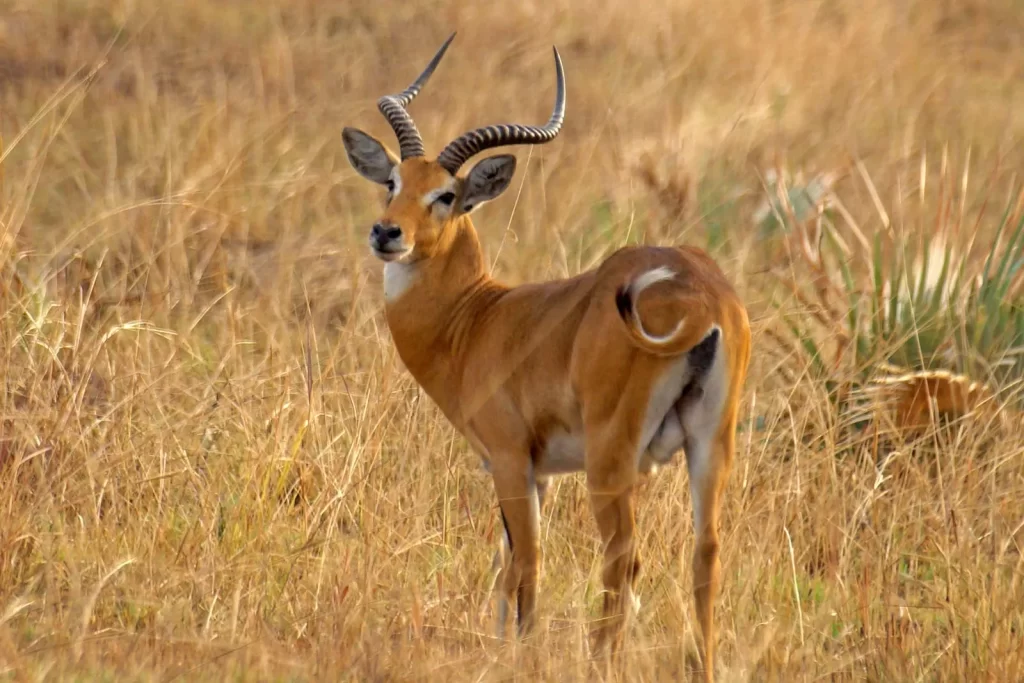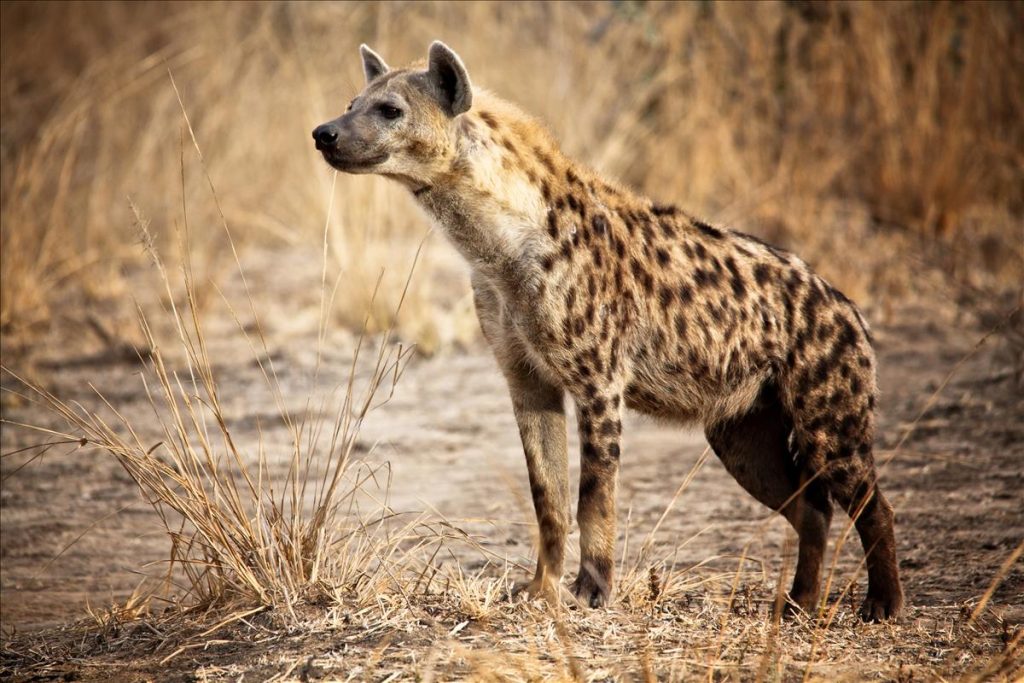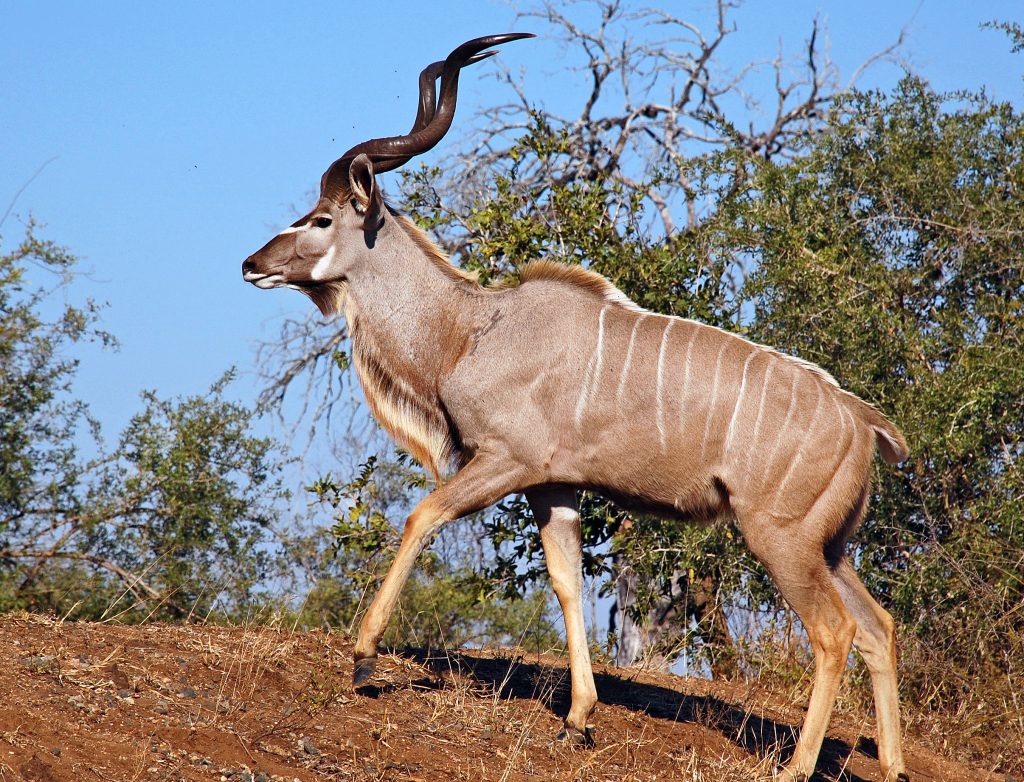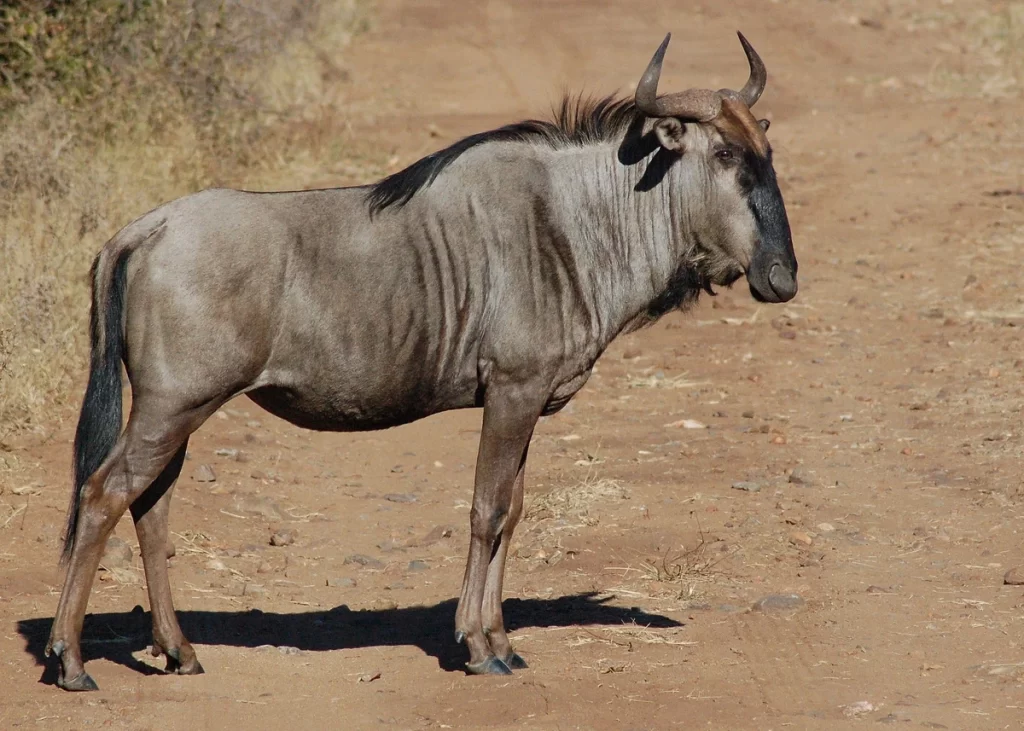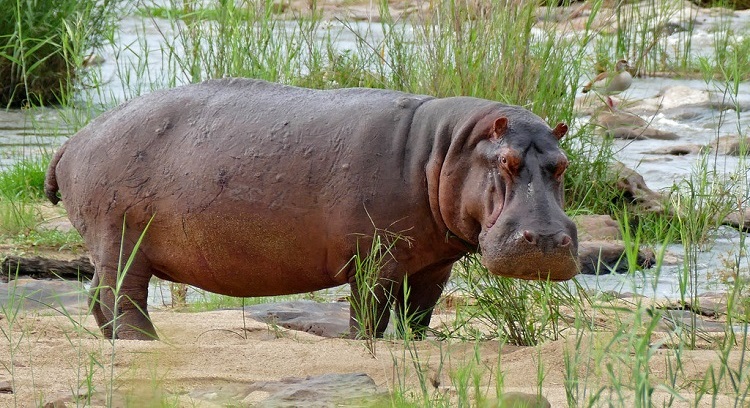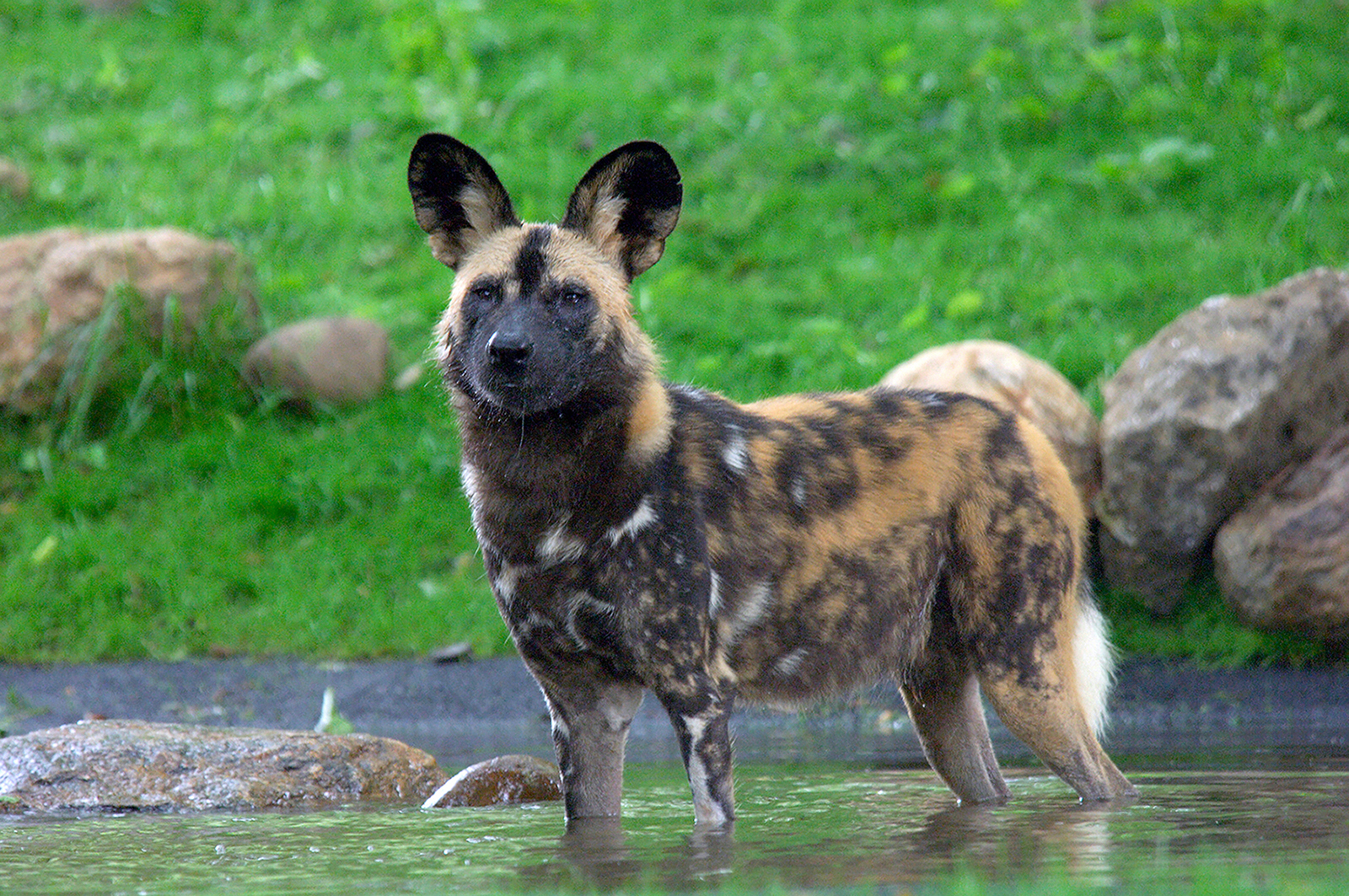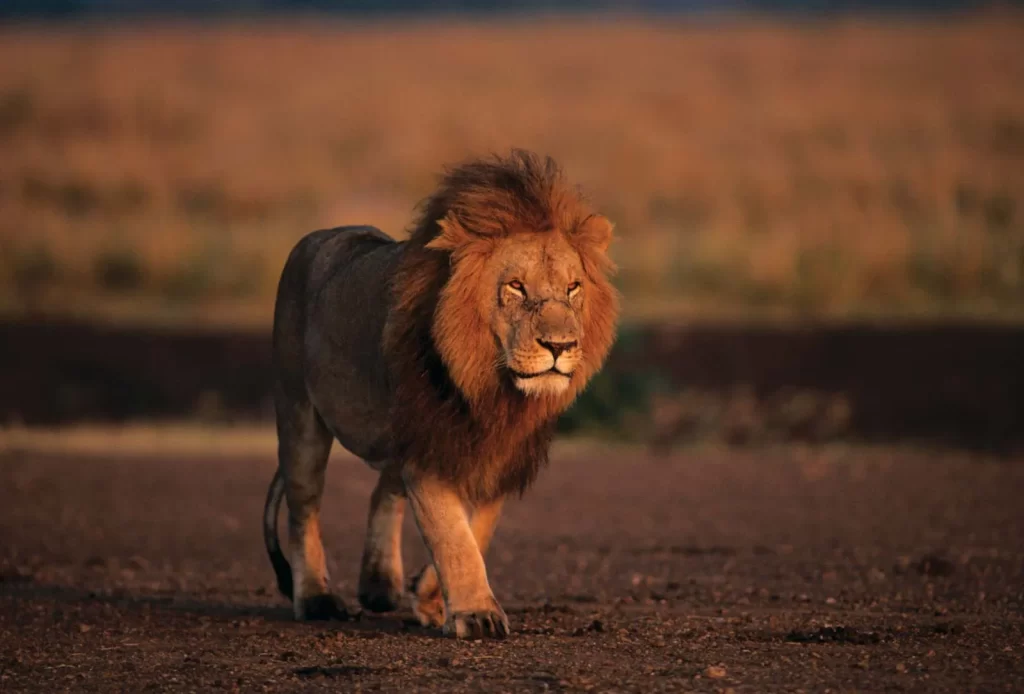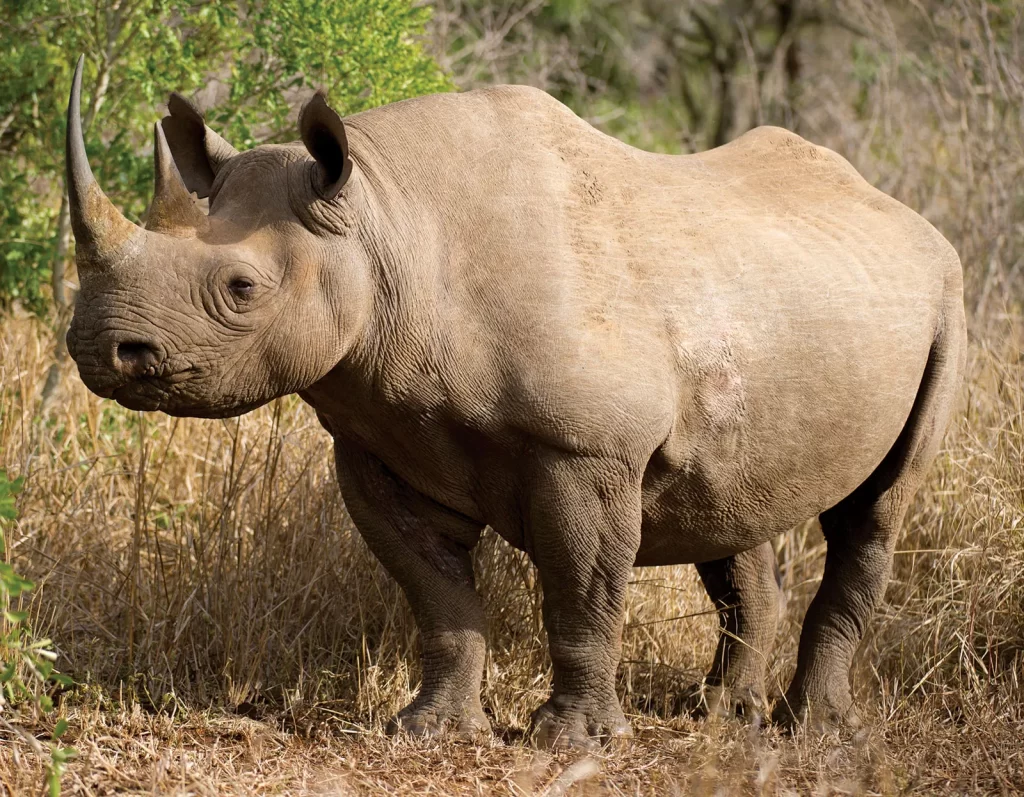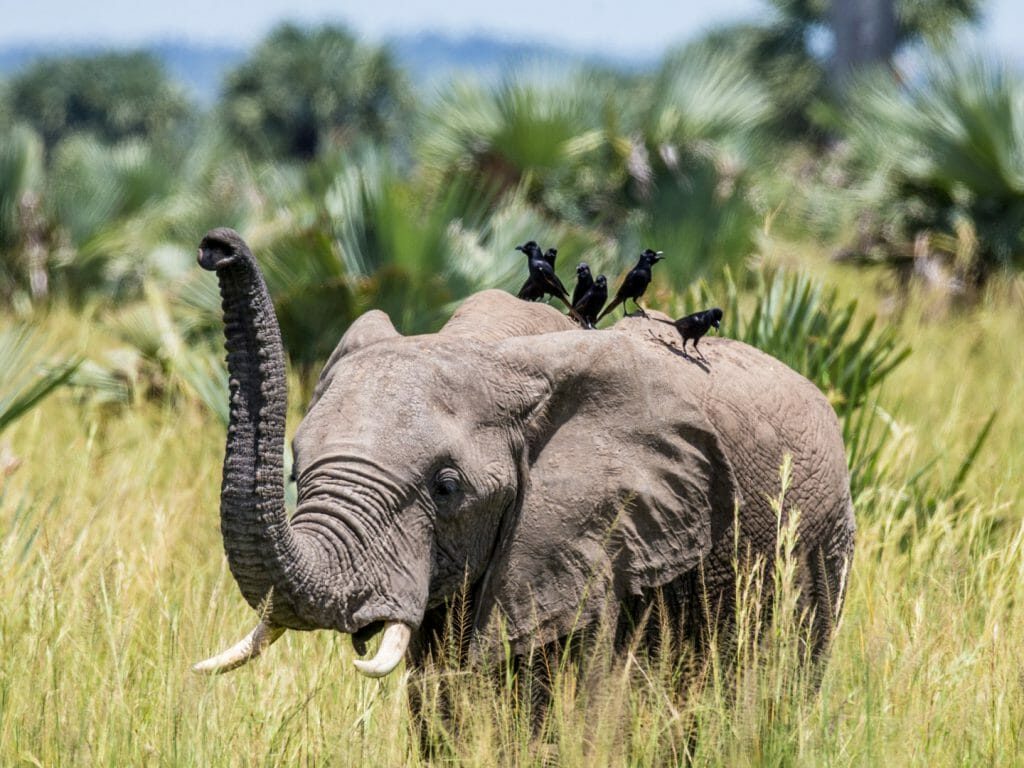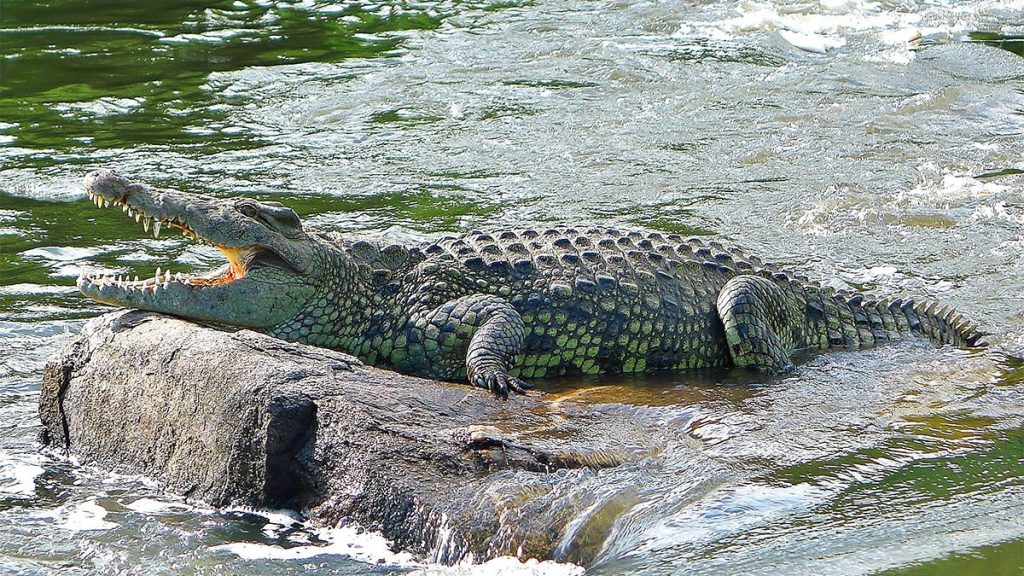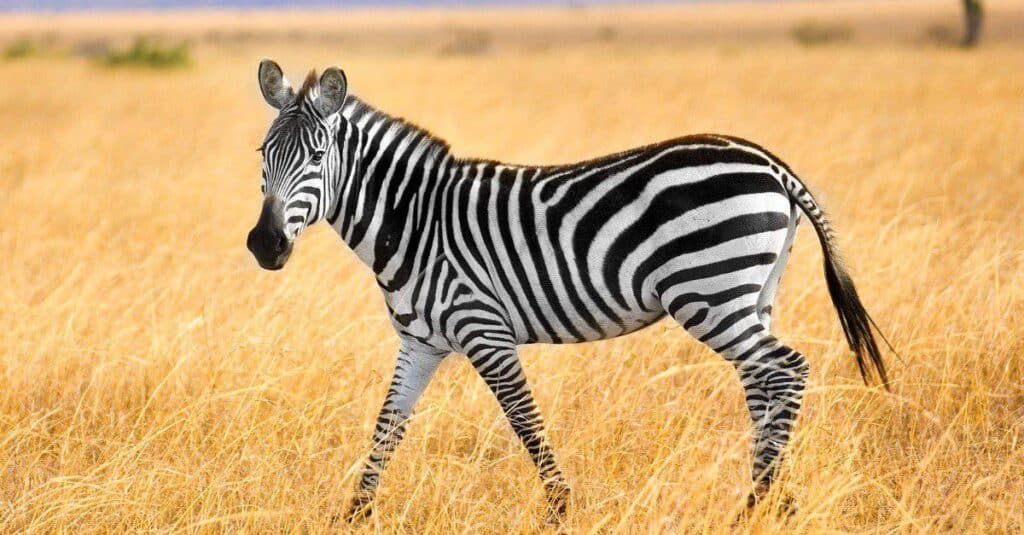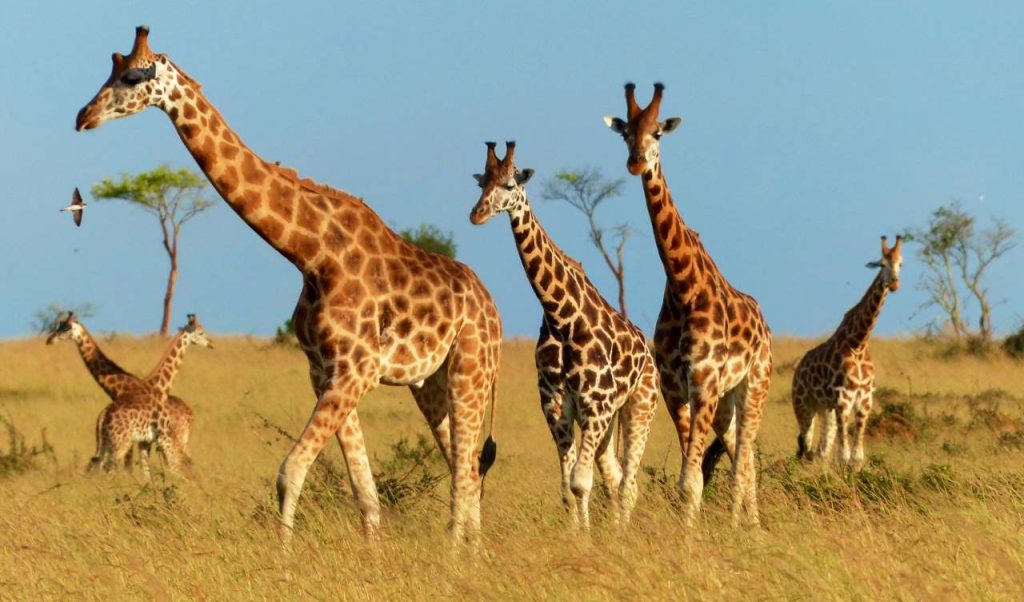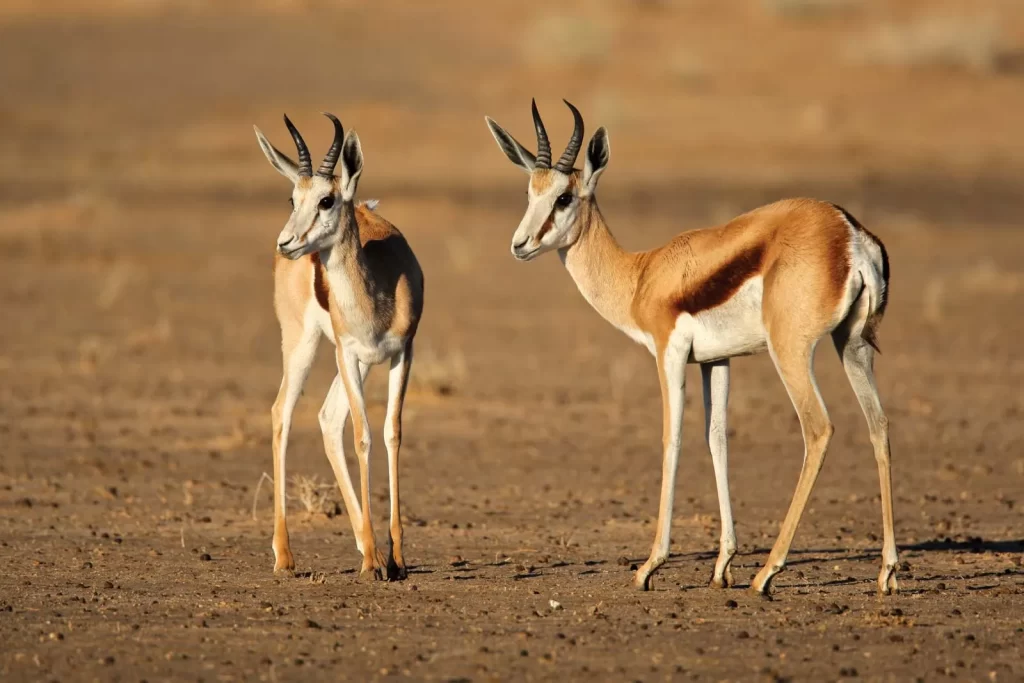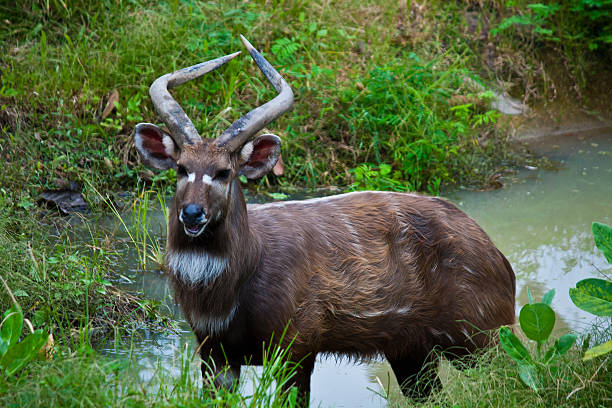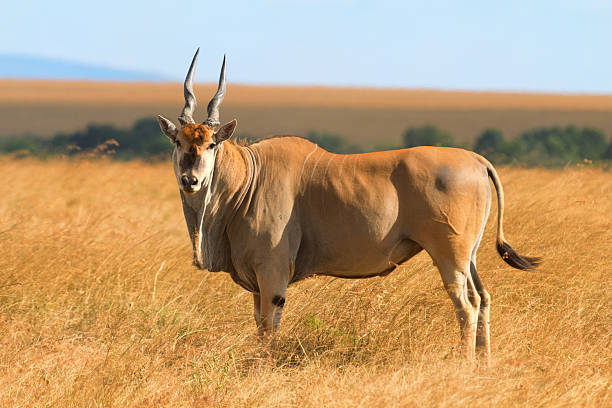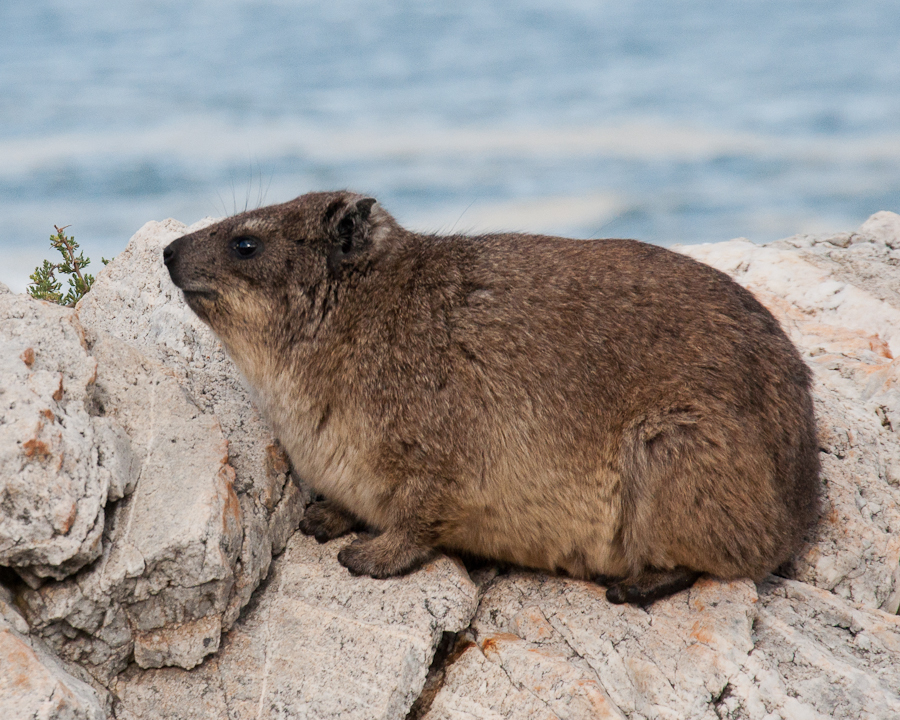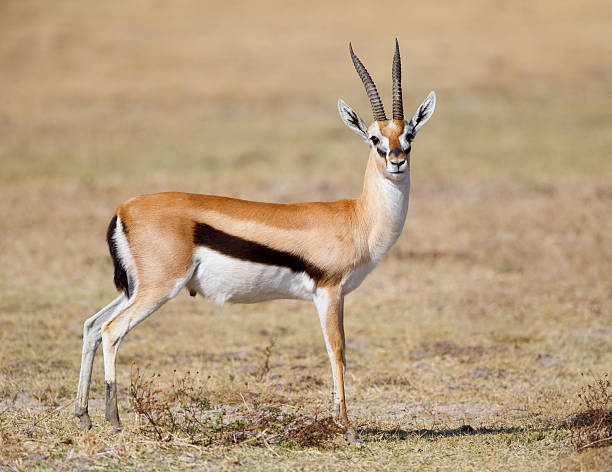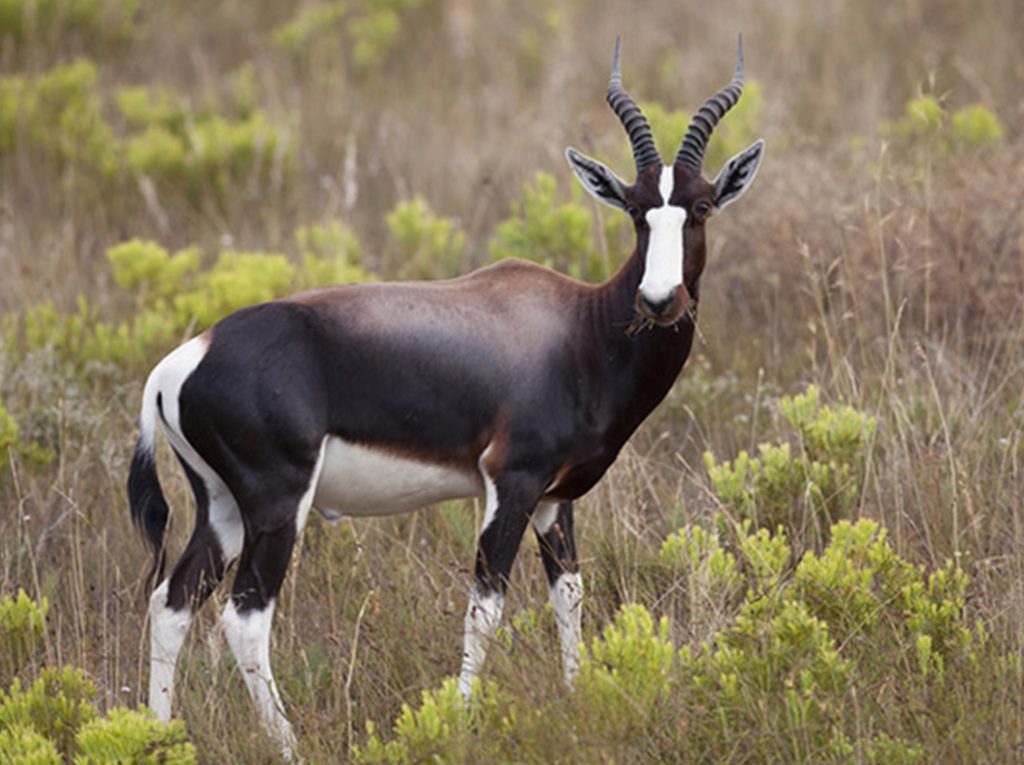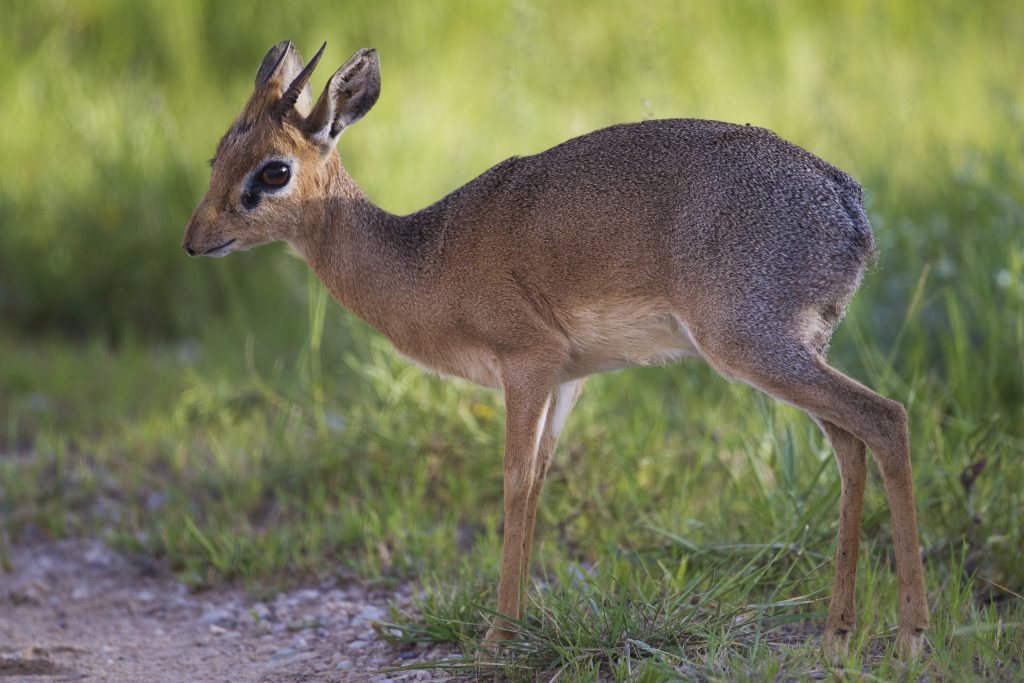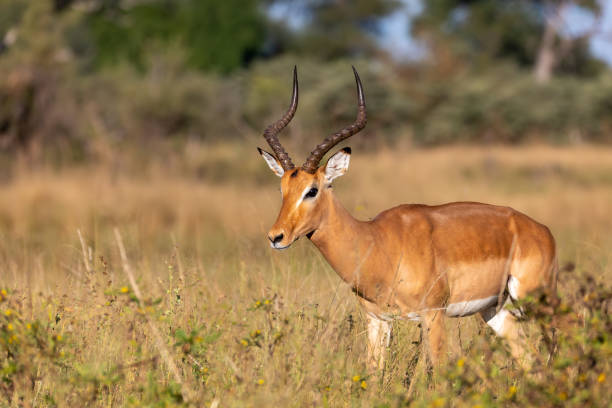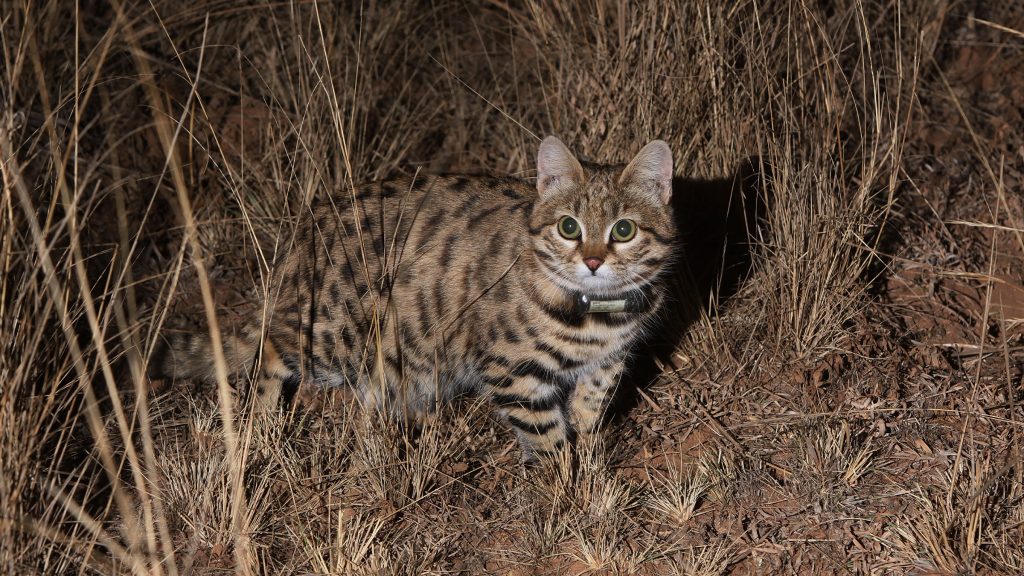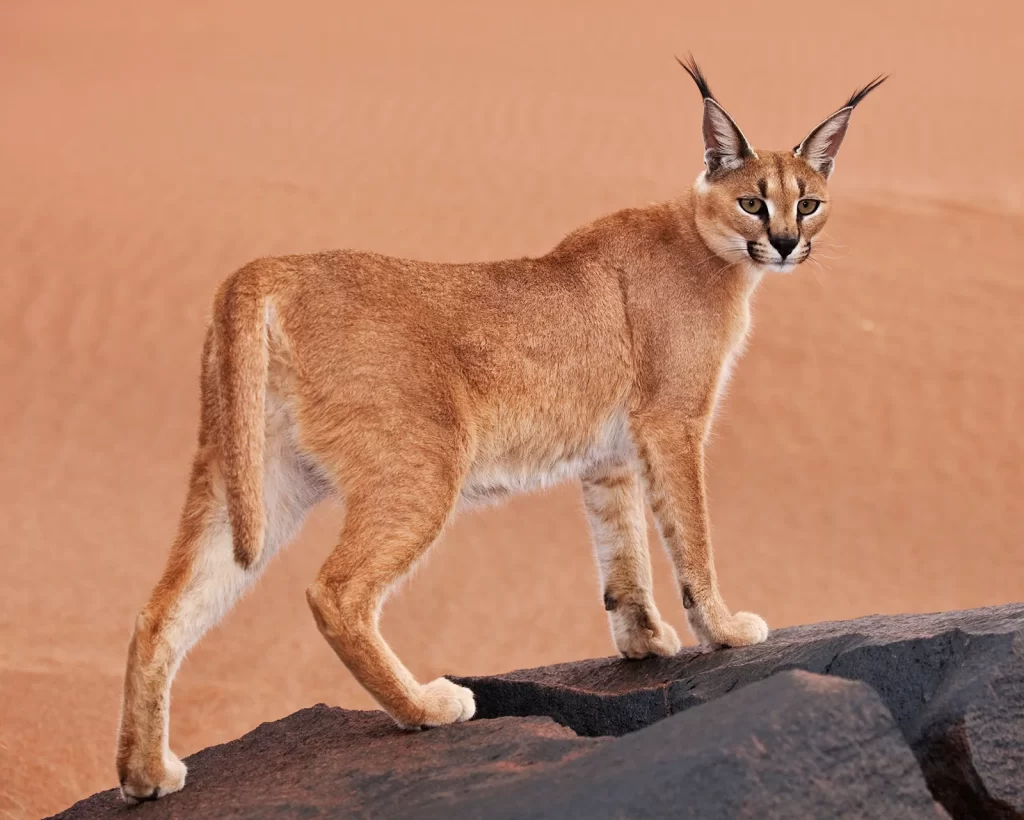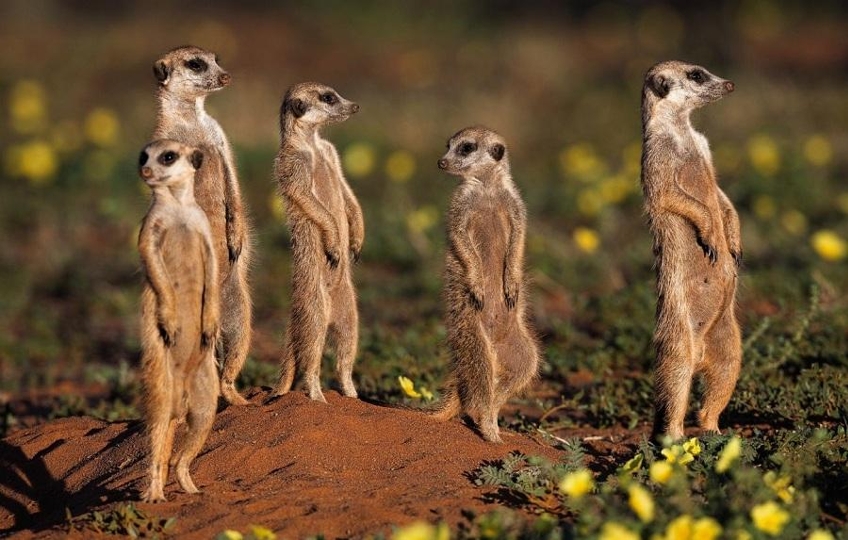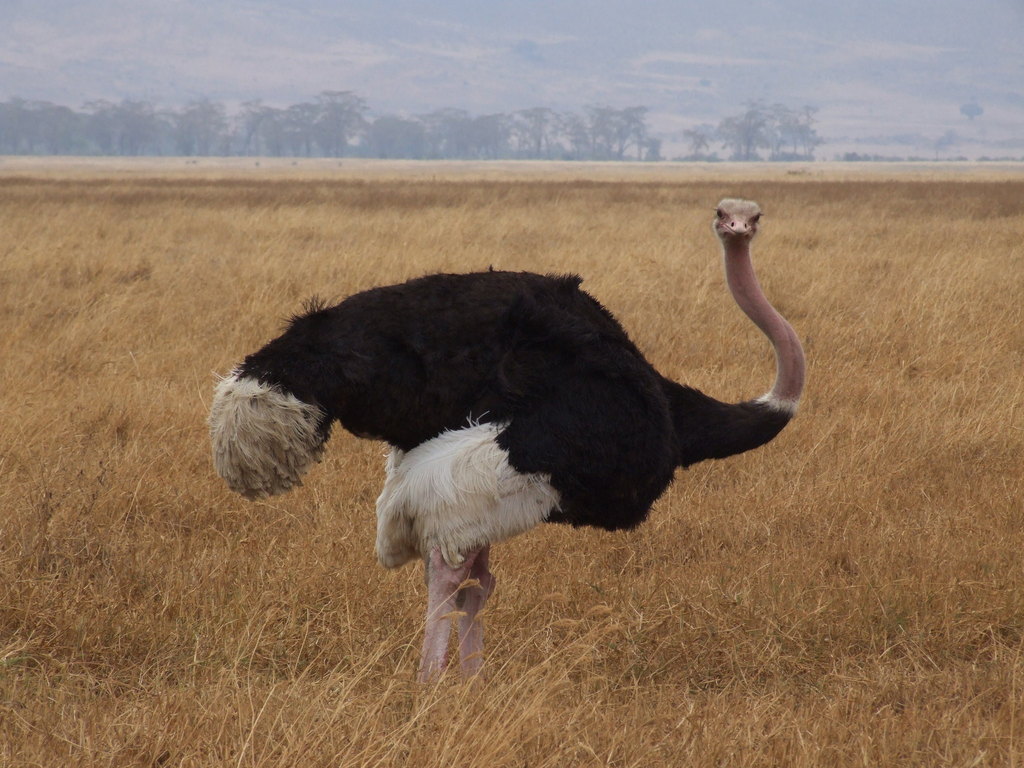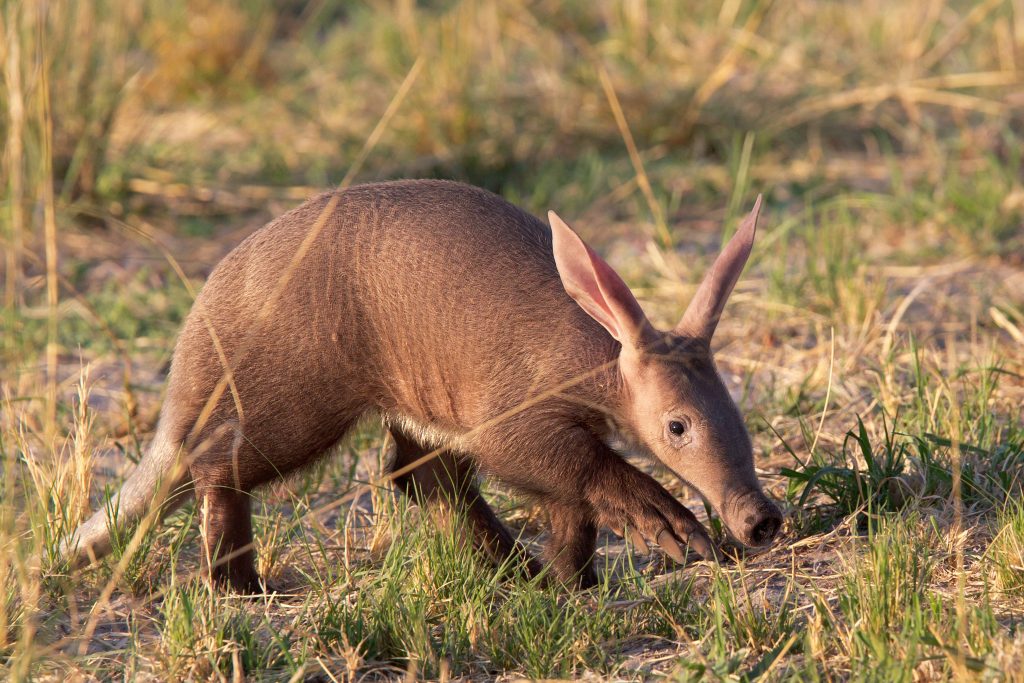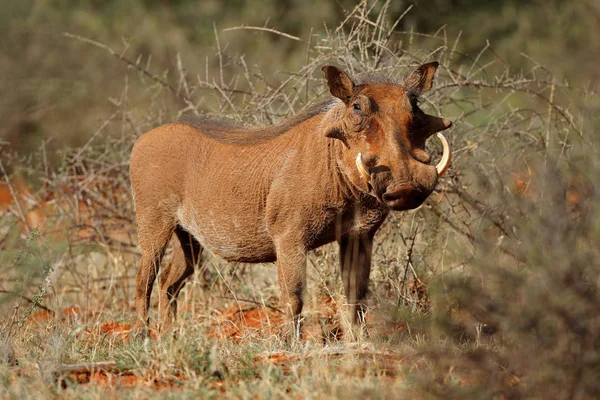Africa has several different types of habitats from savannah grasslands, jungles, swamps, forests to deserts. Africa is the second largest continent after Asia, it is home to many beautiful and cute animals of various sizes, both diurnal and nocturnal. Antelope live in a wide range of habitats. Most live in the African savannahs. However, many species are more secluded, such as the forest antelope, as well as the extreme cold-living saiga, the desert-adapted Arabian oryx, the rocky koppie-living klipspringer, and semiaquatic sitatunga. Remember these animals are distributed throught Africa in different countries and different habitats. Africa’s physical geography, environment is flat, forests, savanna, mountains farmlands cities, lakes and rivers and barren plains that stretch roughly 5,400 kilometers (3,300 miles resources, and human geography can be considered separately. Africa has eight major physical regions: the Sahara, the Sahel, the Ethiopian Highlands, the savanna, the Swahili Coast, the rainforest, the African Great Lakes, and southern Africa.
RELATED Safaris:
2. 14 days Kenya African adventure Safari
3. 24 days Uganda Africa study tour safari Africa
4. 20 days southern Africa
)(4)14 days Keya and Uganda safari
(5) 12-days-east-africa-adventure-safari
(6)21days-study-tour-southern-africa
(1)KOB:
Lifespan: 17 years
speed: 45km/h
Weight: 94kg
Gestation period: 255 days
Description:
The Kob is a medium-sized antelope with a medium brown coat, medium length horns and large ears. Size: Male: 90 to 100 cm. The Kob (Kobus Kob) is an antelope found across Central Africa and parts of West Africa as well as East Africa. Together with the closely related to reedbucks, waterbucks, lechwe, Nile lechwe, and puku, it forms the Reduncinae tribe. Found along the northern savanna, it is often seen in Murchison Falls National Park in Uganda and Queen Elizabeth National Park, Uganda; Garamba and Virunga National Park, and the Democratic Republic of the Congo, as well as grassy floodplains of South Sudan. Kobs are found in wet areas (such as floodplains), where they graze on grass. Kobs are diurnal, but inactive during the heat of the day. They live in groups of either females and calves or just males. These groups generally range from five to 40 animals. The Kob appears on the coat of arms of Uganda, and white-eared kobs (Kobus kob leucotis), found in South Sudan, southwest Ethiopia, and extreme northeast Uganda, participate in large-scale migrations.
(2)Spotted Hyena:
Lifespan: 12 Years
Speed: 64km/h
Weight: 44-64kg
Gestation period: 110 days
Description:
The spotted hyena, also known as the laughing hyena, is a hyena species, currently classed as the sole extant member of the genus Crocuta, native to sub-Saharan Africa. It is listed as being of least concern by the IUCN due to its widespread range and large numbers estimated between 27,000 and 47,000 individuals. The spotted hyena may look unusual, at first sight. It has a large head with a long, thick, muscular neck and powerful jaws that give the hyena the strongest bite of any mammal. Its front legs are longer than its back legs, giving the hyena a profile somewhat like that of a wildebeest or bison.With the ability to exert over 1,100 psi or around 9,000 newtons (depending on the studies you read), spotted hyenas can crack open bones nearly 2 ½ inches in diameter. This allows hyenas to access the nutrient-rich marrow inside that is inaccessible to most other animals.
(3) Kudu.
Lifespan: 20 Years
Speed: 70km/h
Weight: 60-90 kg
Gestation period: 7 to 8mONTHS
Description:
There are two species of spiral-horned antelopes (tribe Tragelaphini, family Bovidae). The very large greater kudu (Tragelaphus strepsiceros) is common in southern African wildlife reserves. The svelte lesser kudu (T. imberbis) is an elusive dweller in the arid lowland thornbush of northeast and East Africa. Both species have corkscrew horns (in males only), depend on cover for food and concealment, and form small herds.
(4) Wildebeest
Life span: 20 years
Speed: 80 km/h
Weight: 200 to 300kg
Gestation period:257 days
Description:
The wildebeest, also called the gnu, is an antelope in the genus Connochaetes native to Eastern and Southern Africa. It belongs to the family Bovidae, which includes antelopes, cattle, goats, sheep, and other even-toed horned ungulates.
Africa’s animal-filled plains and forests live on. The vast wilderness areas are home to the earth’s biggest concentrations of large mammals, from elephants and giraffes to hippos and zebras, to lions, leopards and cheetahs. If you’re a wildlife or animal lover, going on a safari in Africa will be a dream come true. You’ve probably watched nature documentaries and the Lion King and wondered what it might be like to go to Africa and see these amazing creatures for yourself. Maybe you’re wondering what African animals you will actually see on safari? How close can you get to these wild animals.
(5) African Oryx
Life span: 15 years
Speed: 60 km/h
Weight: 220-300kg
Gestation period: 274 days
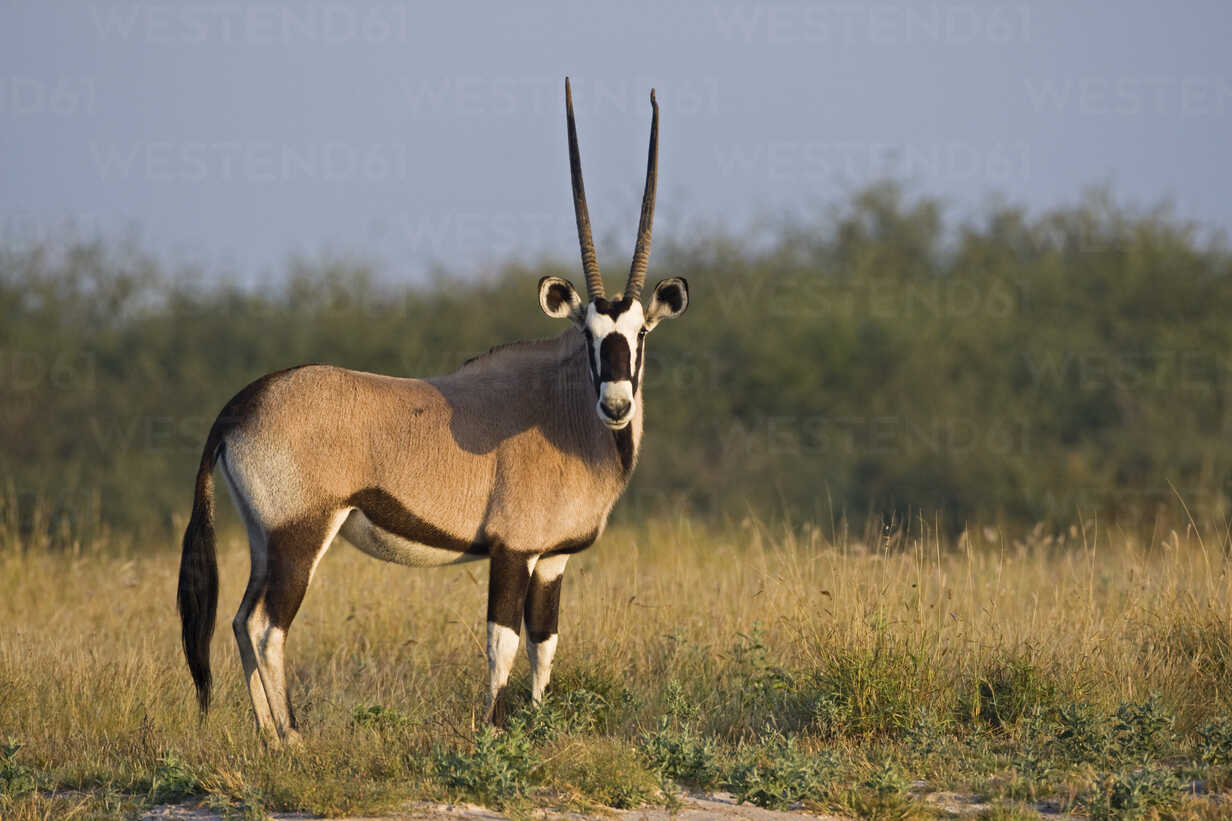
Description:
Oryx is a genus consisting of four large antelope species called oryxes. Their fur is pale with contrasting dark markings in the face and on the legs, and their long horns are almost straight.The oryx refers to four large antelope of the genus Oryx: the Arabian oryx (O. leucoryx), the scimitar-horned oryx (O. dammah), the Beisa oryx (O. beisa – also referred to as the East African oryx) and the gemsbok.Also known as gemsbok, the oryx is visually striking antelope with distinct markings and long, straight horns (30–40 inches) grown by both sexes. Approximately 46 inches at the shoulder and six feet in length, oryx often weight near 226 kg.
(6)Hippopotamus
Life span: 40-50 years
Speed: 48km/h
Weight: 1,500 to 1,800kg
Gestation period: 243 days
Description:
The hippopotamus, also called the hippo, common hippopotamus or river hippopotamus, is a large, mostly herbivorous, semiaquatic mammal and ungulate native to sub-Saharan Africa. It is one of only two extant species in the family Hippopotamidae, the other being the pygmy hippopotamus. Hippopotamuses love water, which is why the Greeks named them the “river horse.” Hippos spend up to 16 hours a day submerged in rivers and lakes to keep their massive bodies cool under the hot African sun. Hippos are graceful in water, good swimmers, and can hold their breath underwater for up to five minutes. However, they are often large enough to simply walk or stand on the lake floor, or lie in the shallows. Their eyes and nostrils are located high on their heads, which allows them to see and breathe while mostly submerged. Hippos are the third-largest living land mammal, after elephants and white rhinos. Despite their large and bulky appearance, they have adaptations to their semi-aquatic environments allowing them to move swiftly on both water and land. Their feet have four-webbed toes that splay out to distribute weight evenly and therefore adequately support them on land, and their short legs provide powerful propulsion through the water.
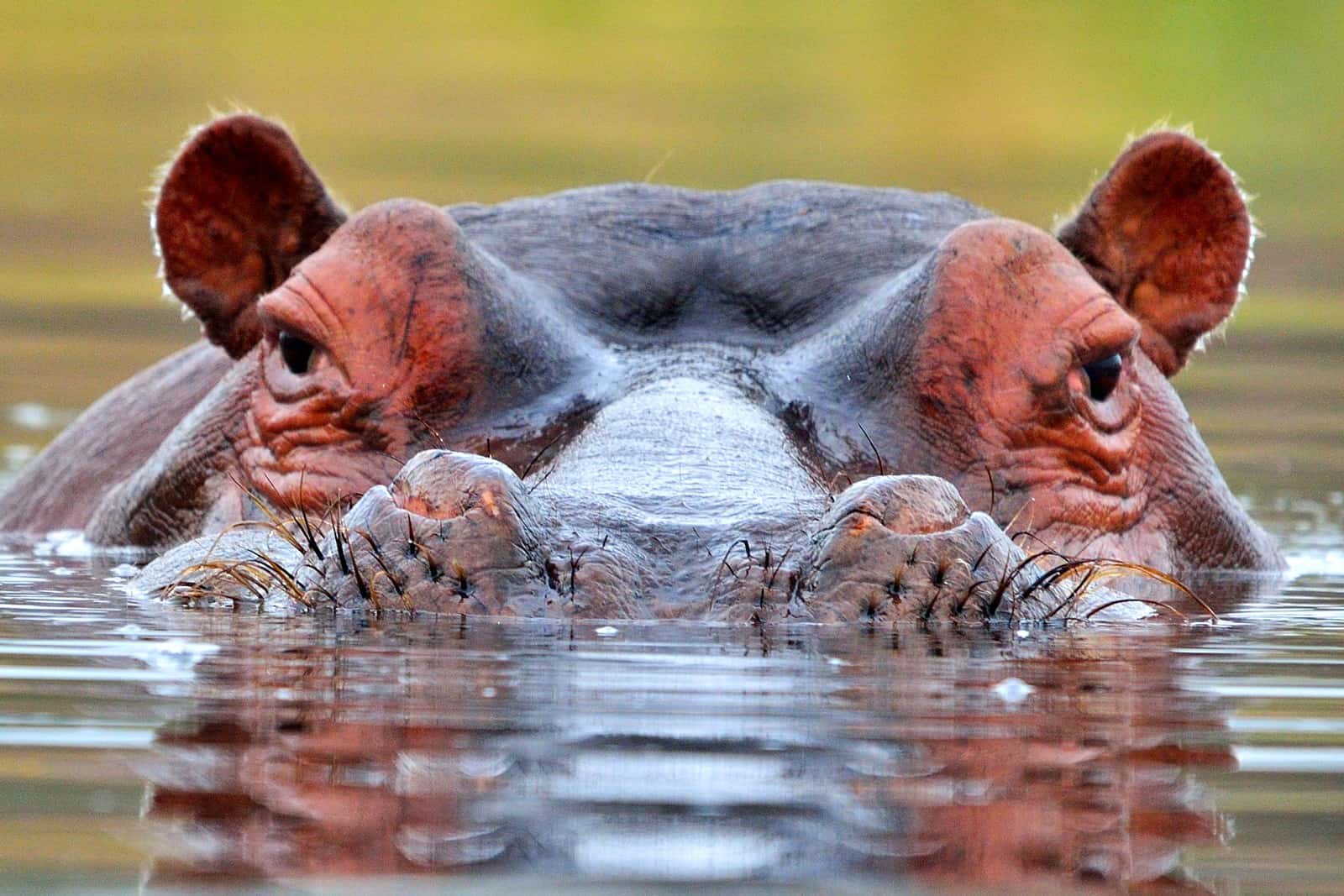
(7) Mountain Gorilla:
Life span: 40-50 years
Speed: 40km/h
Weight: 90-210kg
Gestation period: 8.5 months
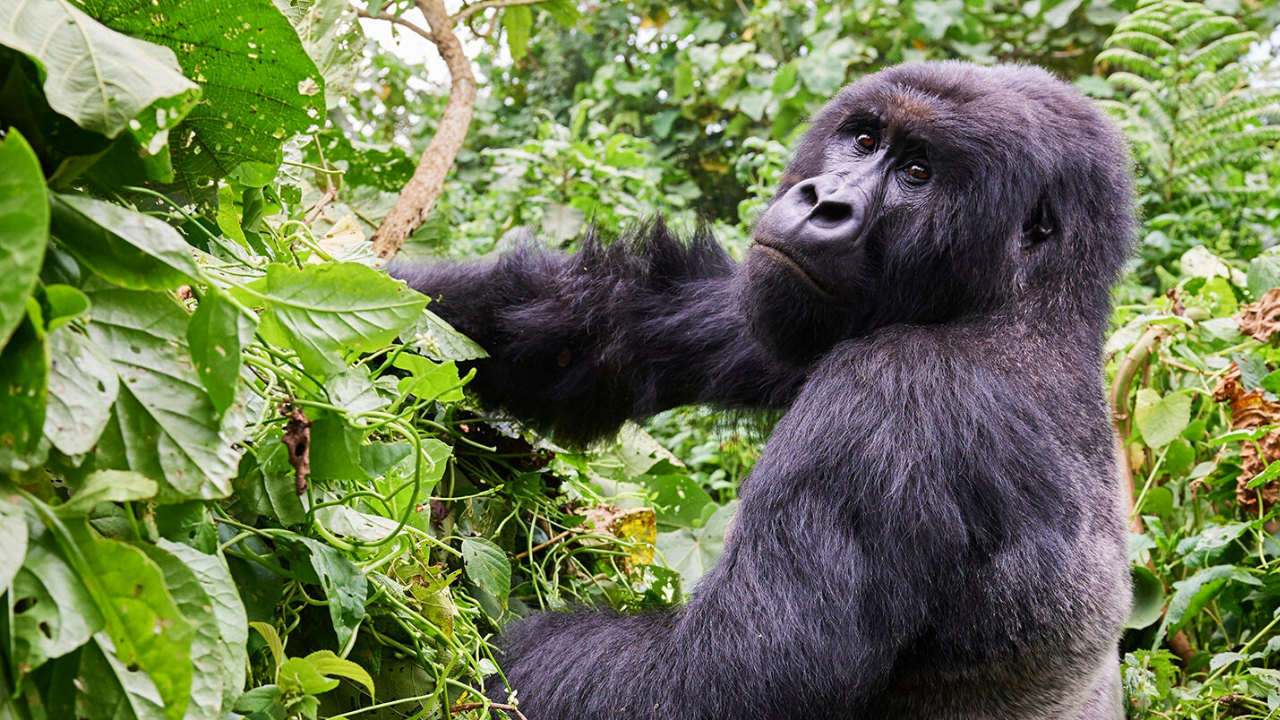
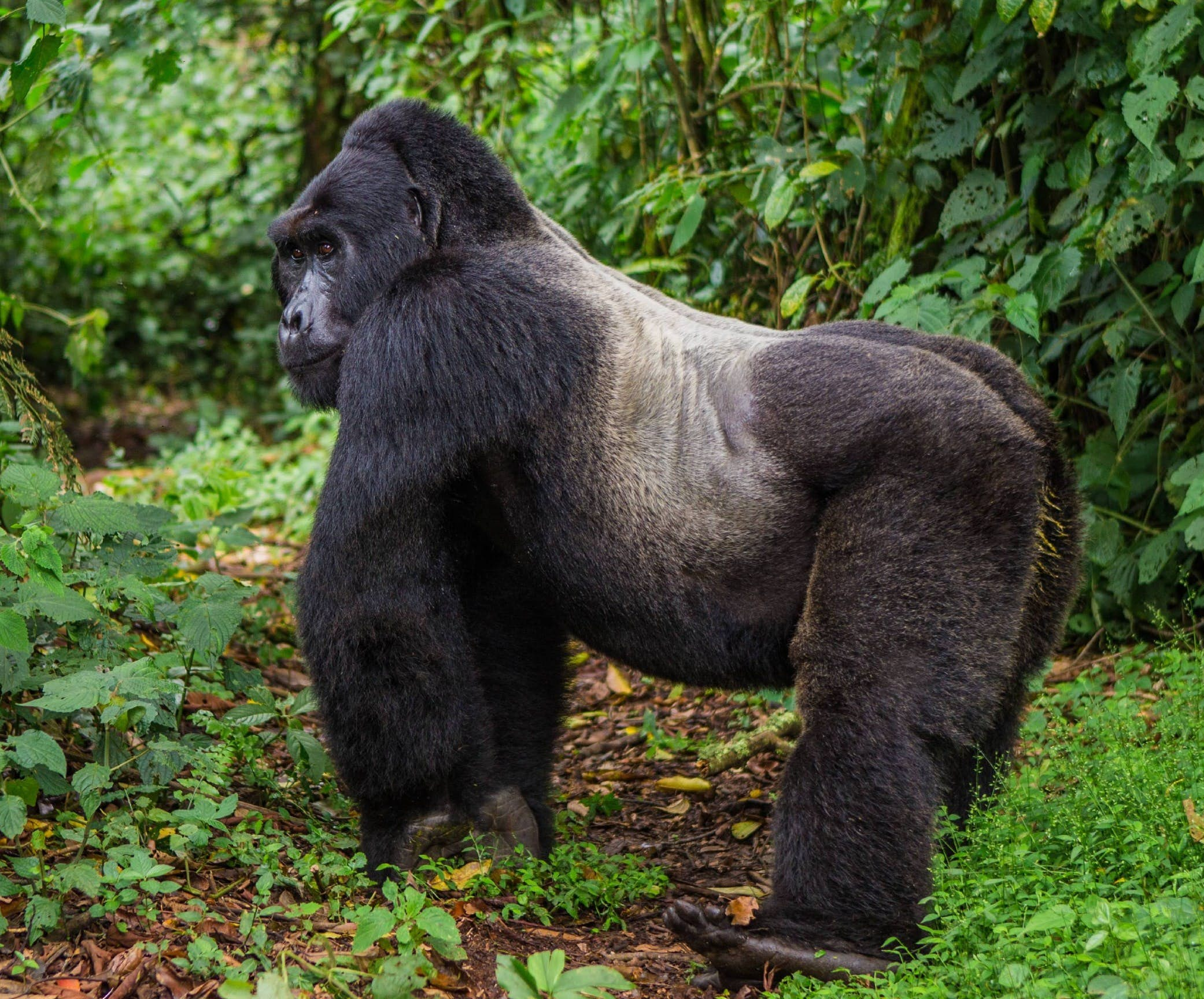
Description:
The mountain gorilla (Gorilla beringei beringei) is one of the two subspecies of the eastern gorilla. Mountain gorillas are found in two separate locations: the Virunga range of extinct volcanic mountains on the borders of the Democratic Republic of Congo (DRC), Rwanda and Uganda, in the Bwindi Impenetrable National Park in Uganda. Thanks to conservation efforts, the population of mountain gorillas has increased from 620 individuals in 1989 to around 1,004 individuals today. Mountain gorillas are peaceful animals they will not attack anyone or anything if they have not be irritated or poked. If you meet them and just go about your business that doesn’t affect them, you will come out of their presence well and unharmed. Most notably, Uganda is home to half of the world’s mountain gorilla population and is one of the few countries where you can encounter them in their natural. A typical silverback weighs 430 pounds (195 kg) and stands 5 feet (1.5m) tall. Silverbacks are incredibly strong and can lift over 1763 pounds (800kg) of dead weight. That’s roughly twice as much as a well trained weightlifter. environment.
(8) Chimpanzee:
Lifespan: 25years
Speed: 40km/h(25mph)
Weight: 34-60kg
Gestation period: 240 days
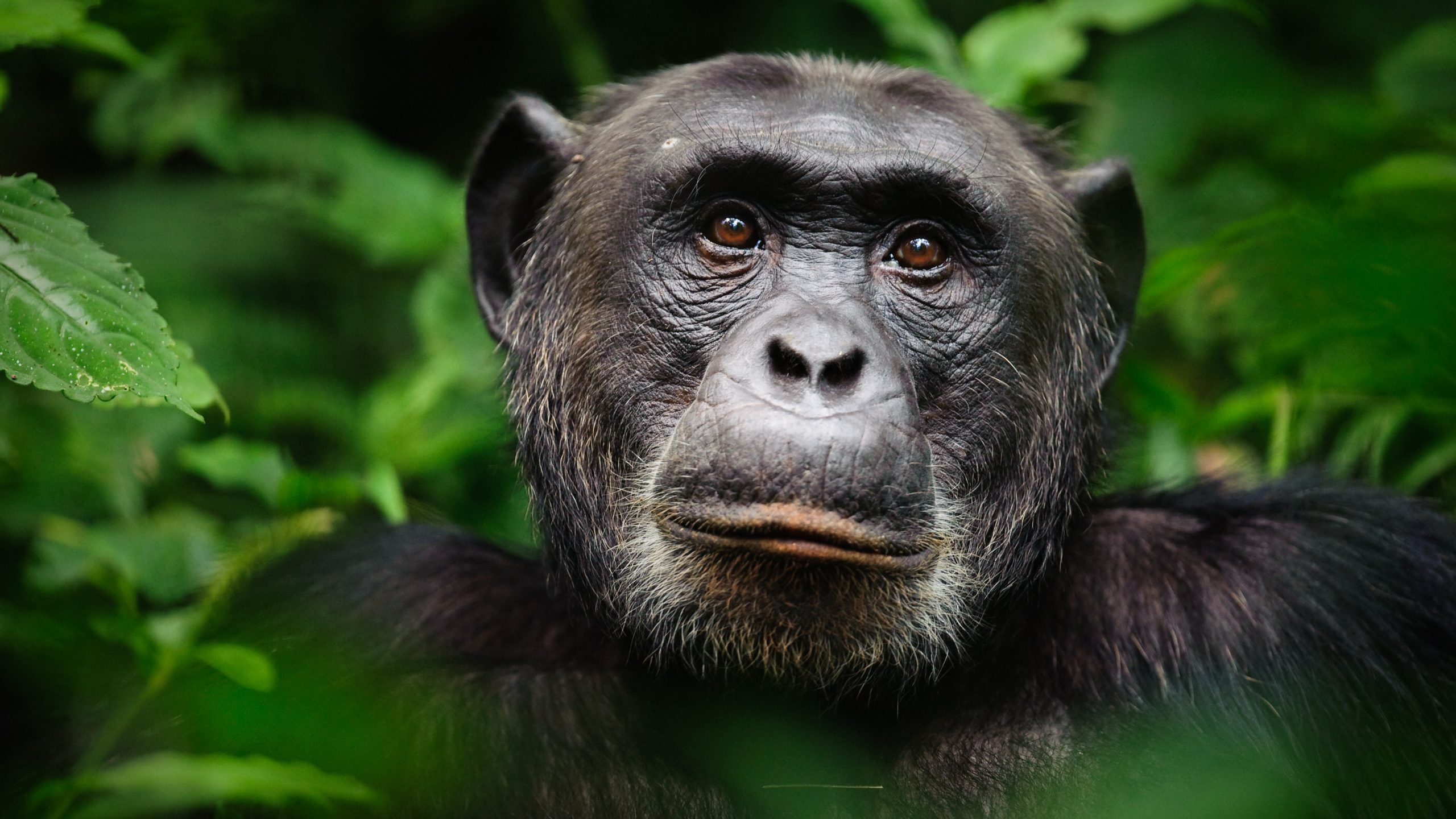
Description:
The chimpanzee, simply chimp, is a species of great ape native to the forest and savannah of tropical Africa. It has four confirmed subspecies and a fifth proposed subspecies. The chimpanzee and the closely related bonobo are classified in the genus Pan. Like us, chimps are highly social animals, care for their offspring for years and can live to be over 50. In fact, chimpanzees are our closest cousins; we share about 98% of our genes. In their habitat in the forests of Central Africa, chimpanzees spend most of their days in the treetops.
Lifespan: :11-20 years
Speed: 48km/h
Weight:100-200kg
Gestation period: 214-242 days
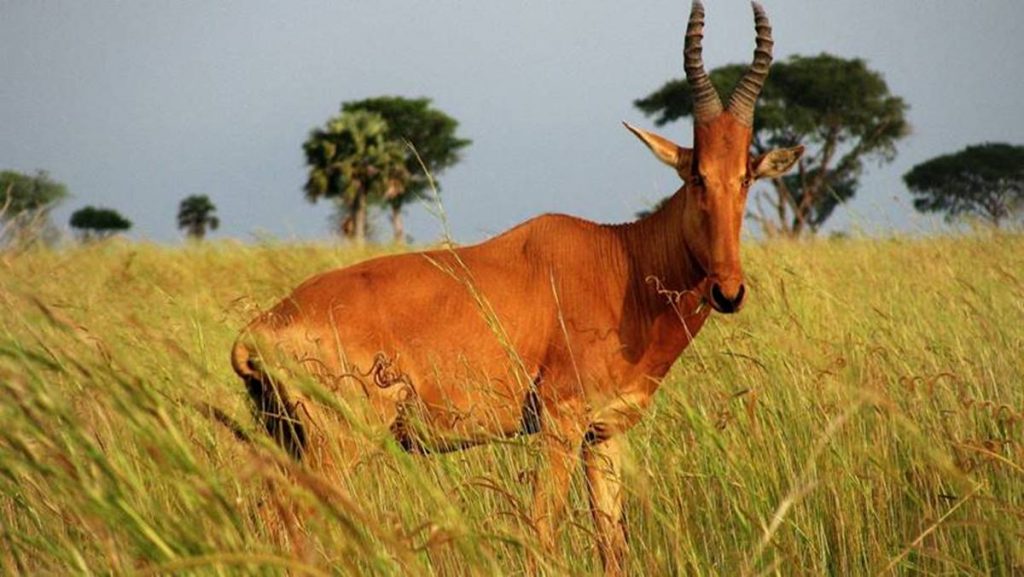
Description:
The hartebeest, also known as kongoni, is an African antelope. Eight subspecies have been described, including two sometimes considered to be independent species. A large antelope, the hartebeest stands just over 1 m at the shoulder, and has a typical head-and-body length of 200 to 250 cm. Our results show that chimpanzee muscle exceeds human muscle in maximum dynamic force and power output by 1.35 times. This is primarily due to the chimpanzee’s higher fast-twitch fiber content, rather than exceptional maximum isometric force or maximum shortening velocities.
Lifespan:15 years
Speed: 70km/h
Weight:110kg
Gestation period: 238 days
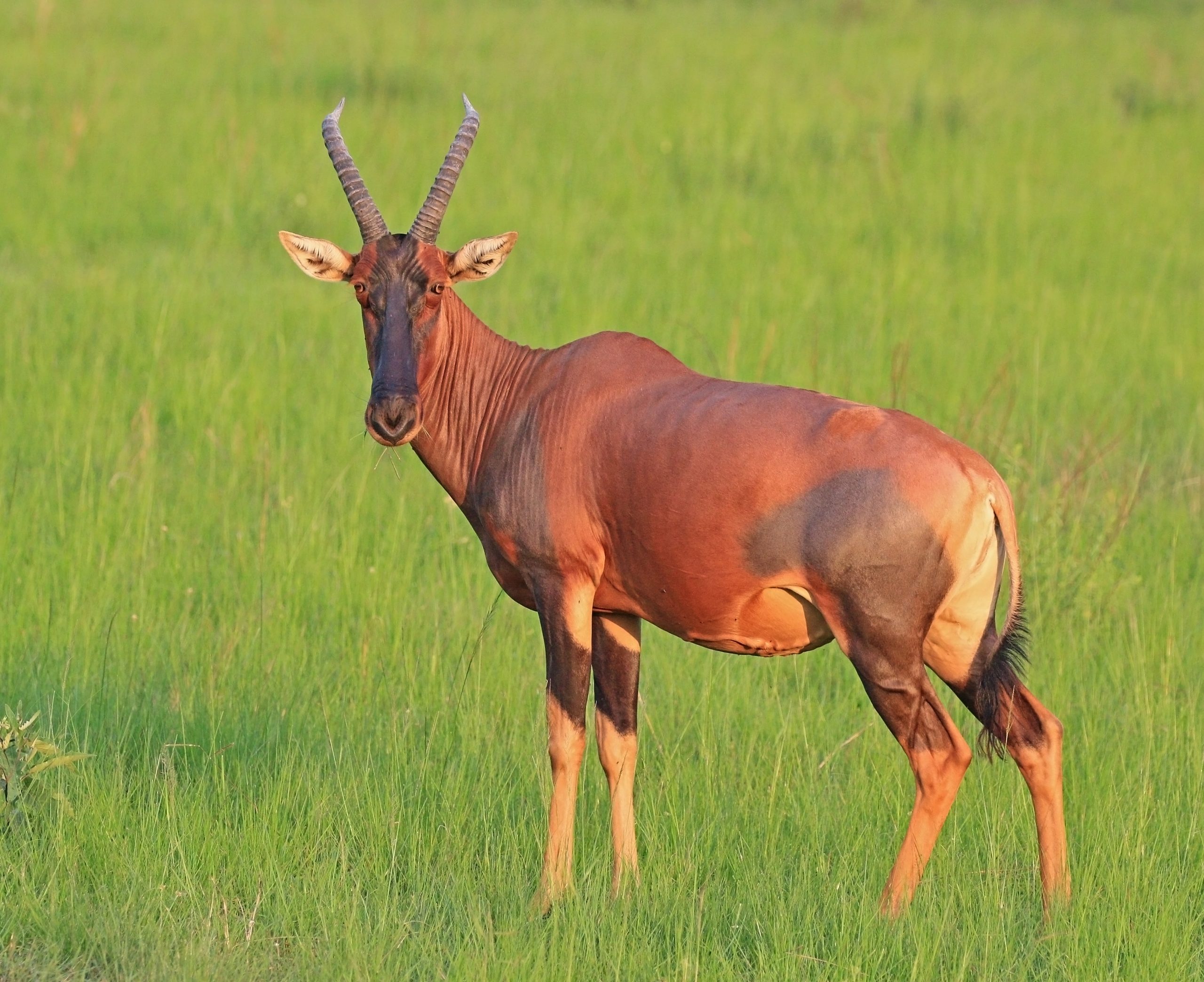
Description:
A relative of tsessebe, topi are highly social and very fast. But while they share a tsessebes’ speed and genetic characteristics, they look more like hartebeest. Topi occupy arid savannah areas across Sub-Saharan Africa but are classified as vulnerable on the IUCN Red List. Topi beat the speed gun at 70 km/h.
Lifespan:
Speed:80-130km/h
Weight:21-72kg
Gestation period: 90-98 days
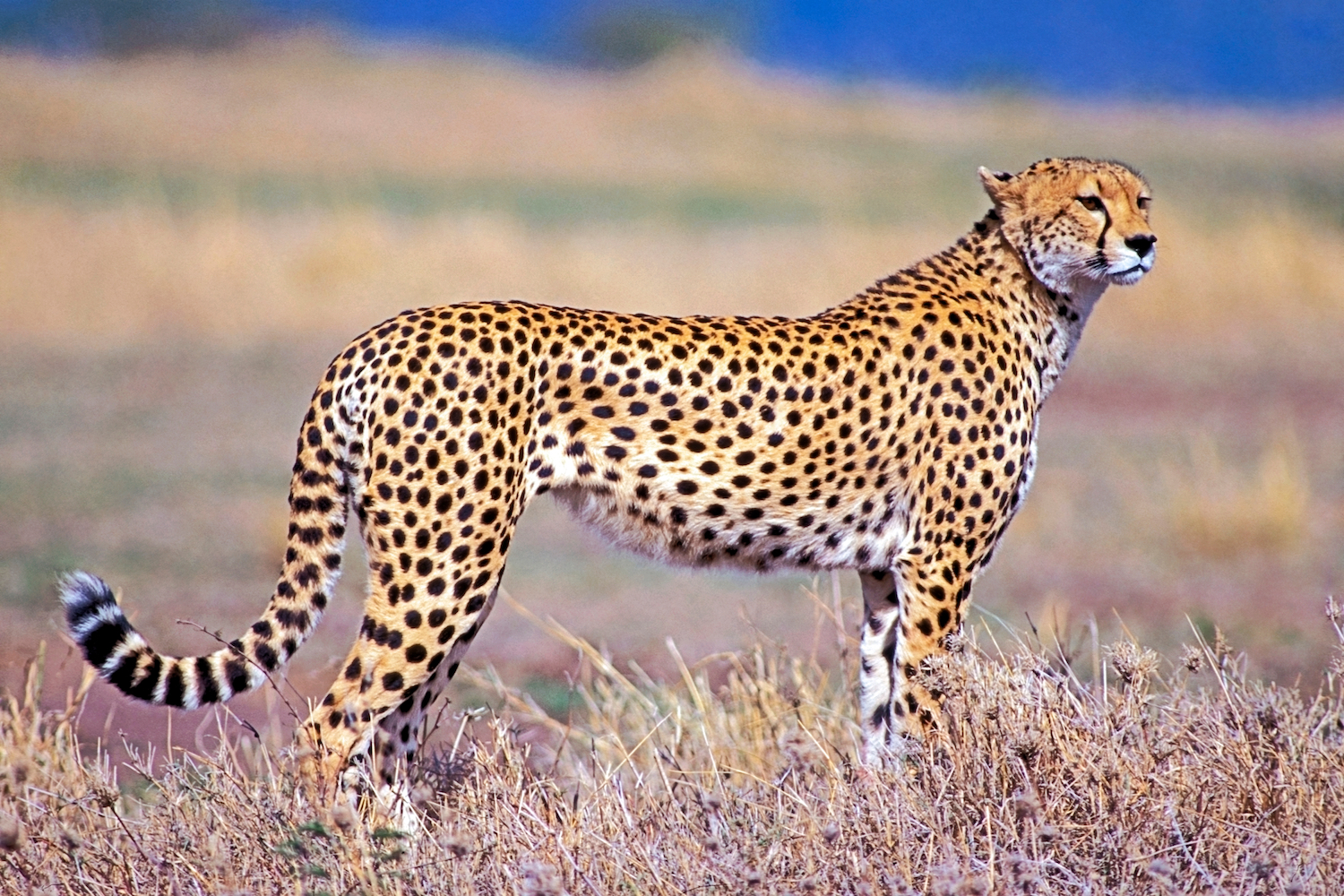
Description:
The cheetah is a large cat native to Africa and central Iran. It is the fastest land animal, estimated to be capable of running at 80 to 128 km/h with the fastest reliably recorded speeds being 93 and 98 km/h, and as such has several adaptations for speed, including a light build, long thin legs and a long tail.
(11) African wild Dog
Lifespan: 10 years
Speed: 70km/h(44mph)
Weight: 22kg
Gestation period: 71 days
Description:
The African wild dog is a canine which is a native species to sub-Saharan Africa. It is the largest wild canine in Africa, and the only extant member of the genus Lycaon, which is distinguished from Canis by dentition highly specialized for a hypercarnivorous diet, and a lack of dewclaws.
The wild dog is one of the world’s most endangered mammals. The largest populations remain in southern Africa and the southern part of East Africa (especially Tanzania and northern Mozambique).
Wild dogs are social and gather in packs of around ten individuals, but some packs number more than 40. They are opportunistic predators that hunt medium-sized ruminants, such as gazelles. In a sprint, African wild dogs can reach speeds of more than 44 miles per hour. African Wild Dogs hunt in packs and can bring down some large mammals. They will eat most any mammal that they can catch and kill including antelopes, impala, wildebeest calves, gazelles, and even large birds like ostriches. African wild dogs live in an organized pack similar to wolves.
Unlike cats, dogs aren’t obligate carnivores. They can and do eat vegetable matter. Wild dogs will search for rotten fruit and will eat the semi-digested contents of their prey’s stomach. Some will dig up vegetables and eat grasses and herbs.
The East African Great Migration:
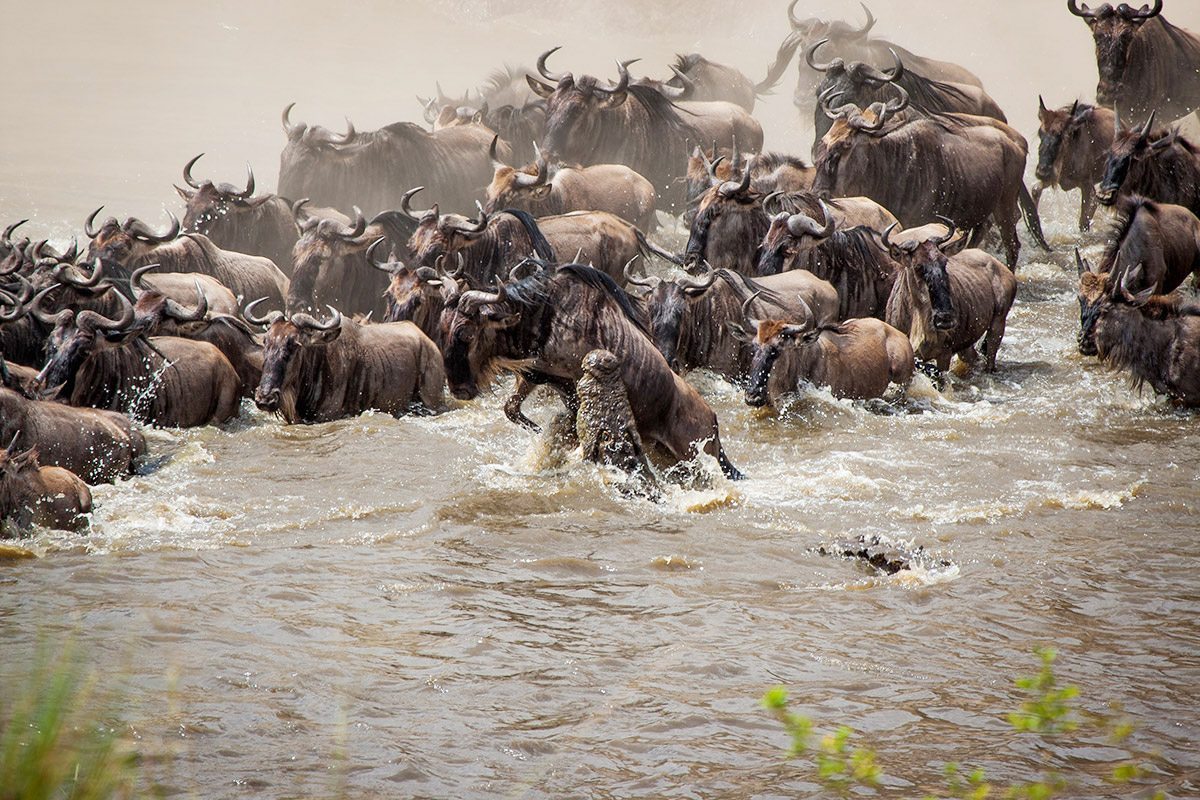
Introduction:
A better representation of the circle of life probably cannot be found anywhere else in the world. The journey starts in Southern Serengeti when wildebeest calves are being born. Predators like lions and hyenas are constantly hunting for babies, and thousands and thousands of calves are born within a couple weeks of each other – a feast for the eyes of true wildlife enthusiasts.
The 800 kilometer trek of the immense wildebeest herd is the largest mammal migration on earth. The timing of the migration coincides with greening of nutritious grasses on the short-grass plains during the wet season. These areas are safer because predators can be easily spotted making it an ideal place for calving. However, the plains dry and the wildebeest are forced to move in search of greener pastures in the western corridor. The northern extension of the ecosystem has the highest rainfall, but the grasses are least nutritious. This is the dry season retreat for the wildebeest, at least until the south becomes green again. The result is a clockwise movement from the south, west, north, and back to the south.

Speed: 50 km/h
Weight: 12-17kgs
Gestation period: 10-14 Months
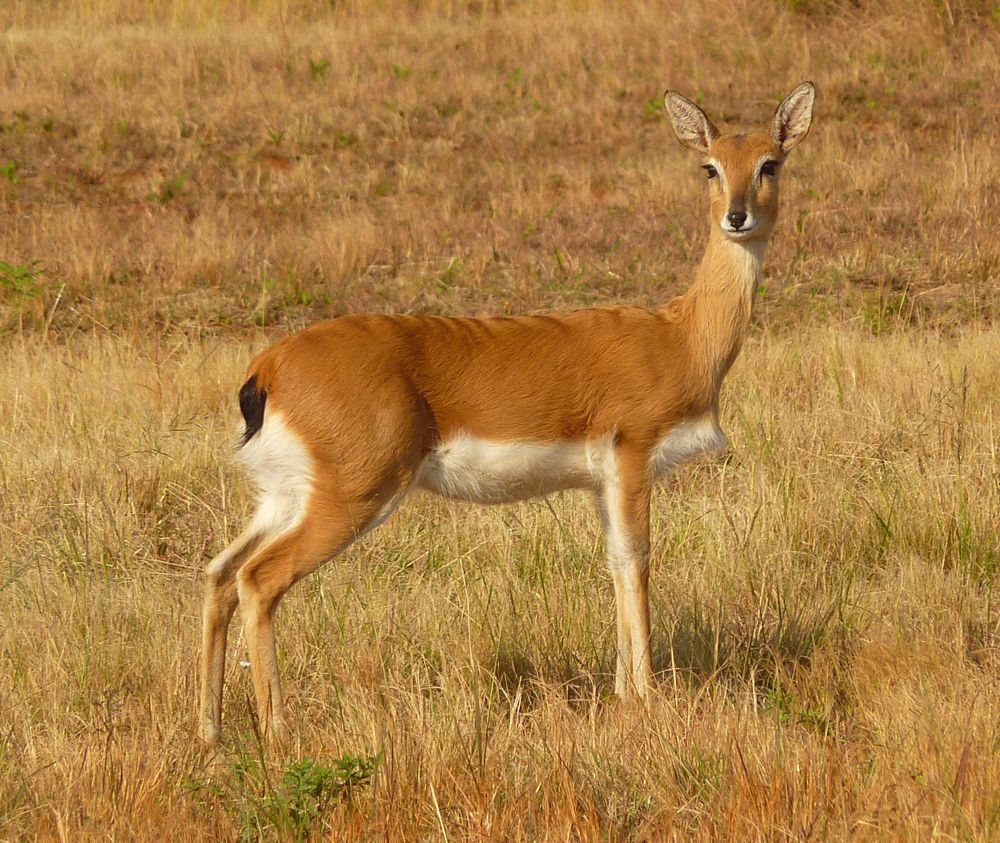
The oribi is a small antelope found in eastern, southern and western Africa. The sole member of its genus, it was first described by the German zoologist Eberhard August Wilhelm von Zimmermann in 1783. Eight subspecies are identified. The oribi is a small, slender antelope; it reaches nearly 50–67 centimetres (20–26 in) at the shoulder and weighs 12–17 kilograms (26–49 lb). … This antelope features a slightly raised back, and long neck and limbs. The glossy, yellowish to rufous brown coat contrasts with the white chin, throat, underparts and rump.
(13) Klipspringer:
Lifespan: 15 Years
Speed: 45km/h
Weight: 8-18 kg
Gestation Period: 6-7 months
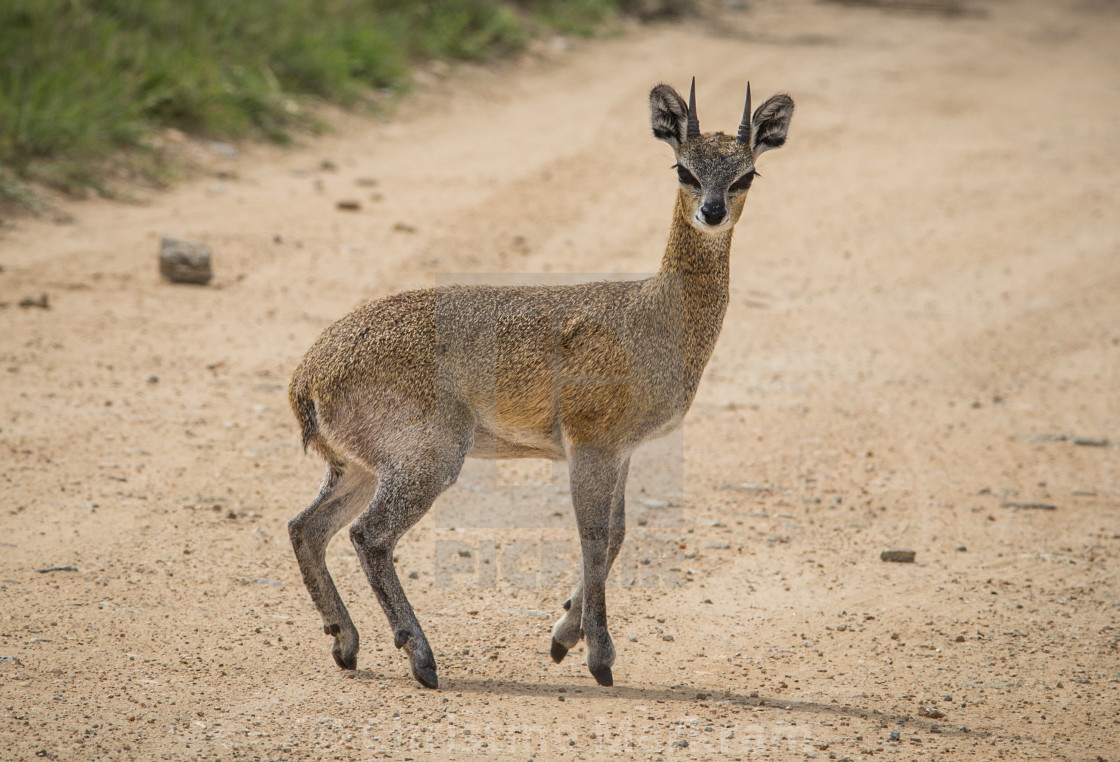
The klipspringer is a small antelope found in eastern and southern Africa. The sole member of its genus, the klipspringer was first described by German zoologist Eberhard August Wilhelm von Zimmermann in 1783.Klipspringer are around 1.5m (5′) tall and can jump 10 times their own body height! They are the highest jumping mammals in relation to their body size.
(14)Africa’s big five animals:
Africa Big 5 animals is a term coined back in the 1800s by trophy hunters, referring to what they considered the most challenging and dangerous animals to hunt on foot. These include the African Elephant, Lion, Leopard, African Buffalo, and Rhinoceros. Today the term is primarily famous with Africa safari travelers who now shoot the big five with a camera rather than a lethal weapon of choice. The Africa big 5 animals are all present in Uganda and can easily be seen in all savanna parks.
The phrase today is commonly used to market safaris. However, back in the nineteenth and early twentieth centuries, everyone from European royalty to American presidents wanted to bag an African hunting trophy—the larger and more unpredictable the beast, the better – how the Big Five became famous.
(A) Lion:
Lifespan: 10-15 years
Gestation period: 110 days
Speed: 80 km/h
The lion is a large felid of the genus Panthera native mainly to Africa. It has a muscular, deep-chested body, short, rounded head, round ears, and a hairy tuft at the end of its tail. It is sexually dimorphic; adult male lions have a prominent mane.
(B) leopard
Life span:12 – 17 years
Speed: 58km/h
Gestation period:90 – 105 days
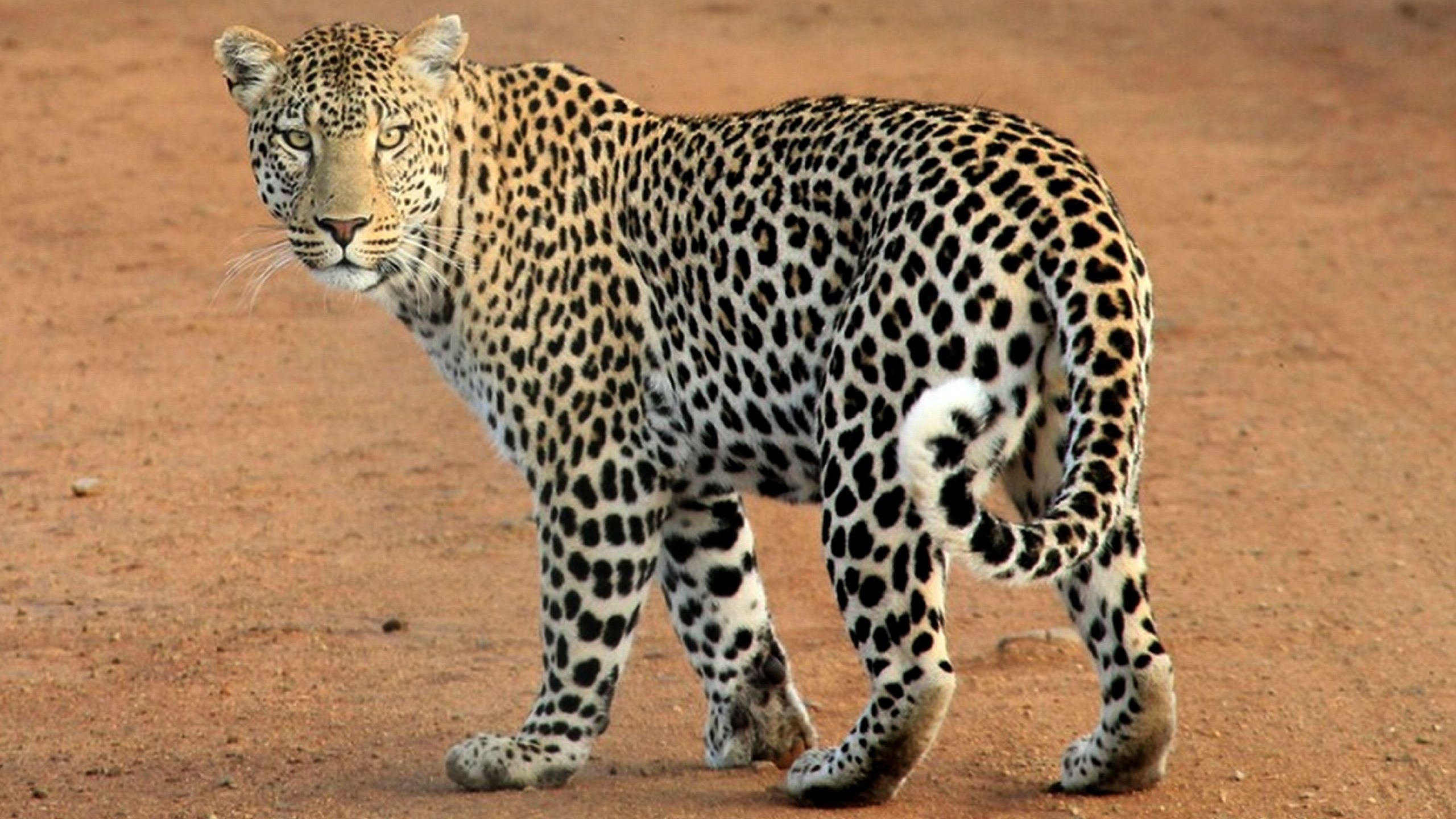
The leopard is one of the five extant species in the genus Panthera, a member of the cat family, Felidae. It occurs in a wide range in sub-Saharan Africa, in some parts of Western and Central Asia, Southern Russia, and on the Indian subcontinent to Southeast and East Asia
(C) African Buffalo
Life span: 20-25 years
weight:300-900kg
Speed: 56km/h (35mph)
Gestation period: 11 months
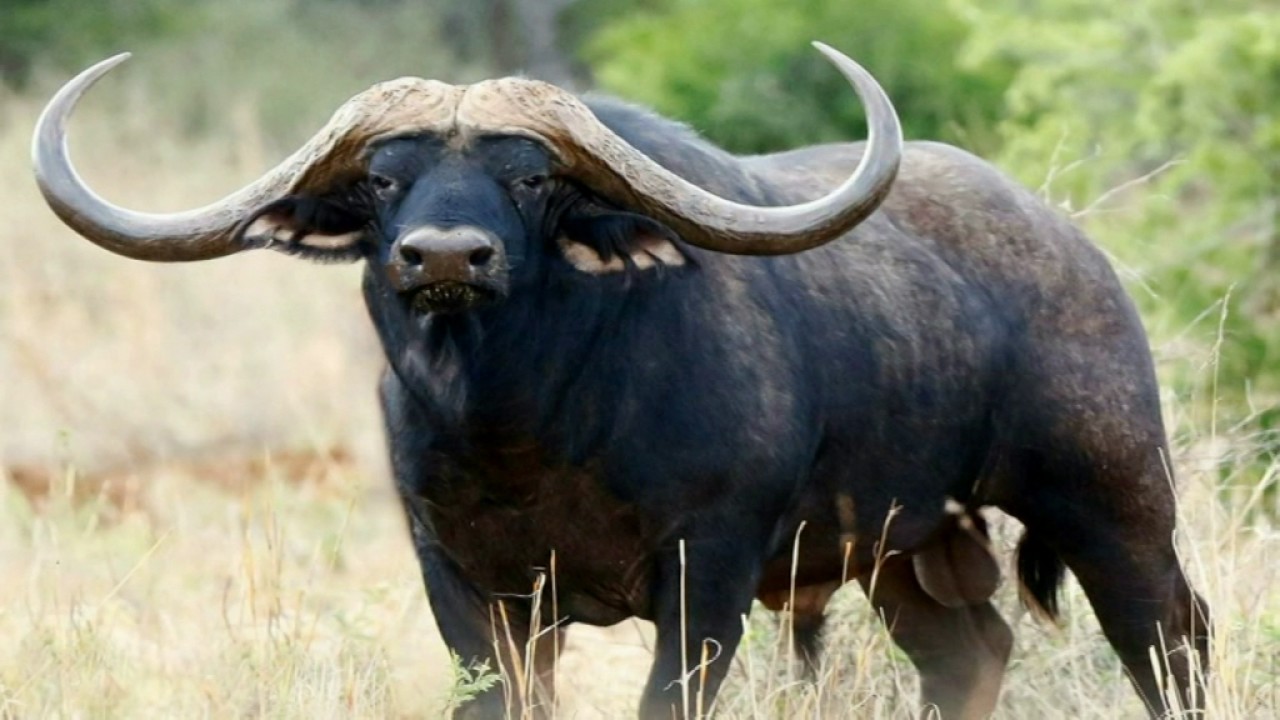
The African is a large sub-Saharan African bovine. Syncerus caffer caffer, found in East African countries and southern African countries. African Buffalo do not have very good eyesight but their hearing and especially their smell is exceptional. … They are often found eating insects off the buffalo and will also warn the buffalo of approaching danger. The old saying that an Elephant never forgets, well a Buffalo never forgives! a buffalo has a massive head and boss (horns), a broad chest and sturdy legs. It’s said to be four times stronger than an ox. Buffaloes are herbivores, and so eat only vegetation. Their favorite foods are grass and herbs, but water buffalo will also eat aquatic plants. Both African and Asian buffalo will eat shrubs and trees when they can’t find grass or herbs to eat.
(D)Rhinoceros
-
Life span: 40-50 years
-
Weight: 800-1400kg
-
Speed: 55km/h
-
Gestation period: 15-16 months
Description;
A rhinoceros, commonly abbreviated to rhino, is a member of any of the five extant species of odd-toed ungulates in the family Rhinocerotidae, as well as any of the numerous extinct species therein. Two of the extant species are native to Africa. Black rhinos are browsers that get most of their sustenance from eating trees and bushes. They use their lips to pluck leaves and fruit from the branches. White rhinos graze on grasses, walking with their enormous heads and squared lips lowered to the ground. Rhinos’ eyesight isn’t great – they’re unable to see a motionless person at a distance of 30m – they mainly rely on their strong sense of smell.
(E) African Elephant
Life span: 60 to 70 years
Weight:6,000-8,000 kg
Speed:40km/h
Gestation period: 18-22 months
Description;
Elephants are the largest existing land animals. Three species are currently recognised: the African bush elephant, the African forest elephant, and the Asian elephant. Elephantidae is the only surviving family of the order Proboscidea; extinct members include the mastodons.
Elephant’s Memory:
Elephants do have incredible memories. Researchers who studied African elephants in the wild learned that older, female elephants (called “matriarchs”) often lead herds. These matriarchs build up a strong memory over time that allows them to remember friends and enemies.
Elephant’s Hearing:
Elephants have some of the best hearing around. They can hear at frequencies 20 times lower than humans. It isn’t just their ears that perceive sound; these majestic beasts also have receptors in their trunks and feet that are excellent at picking up low-frequency vibrations.
Elephant’s Smell:
Elephants have a keen nose. They have more smell receptors than any mammal – including dogs – and can sniff out food that is several miles away. A new study tests their ability to distinguish between similar smelling plants. … And for sense of smell, the biggest is one of the best.
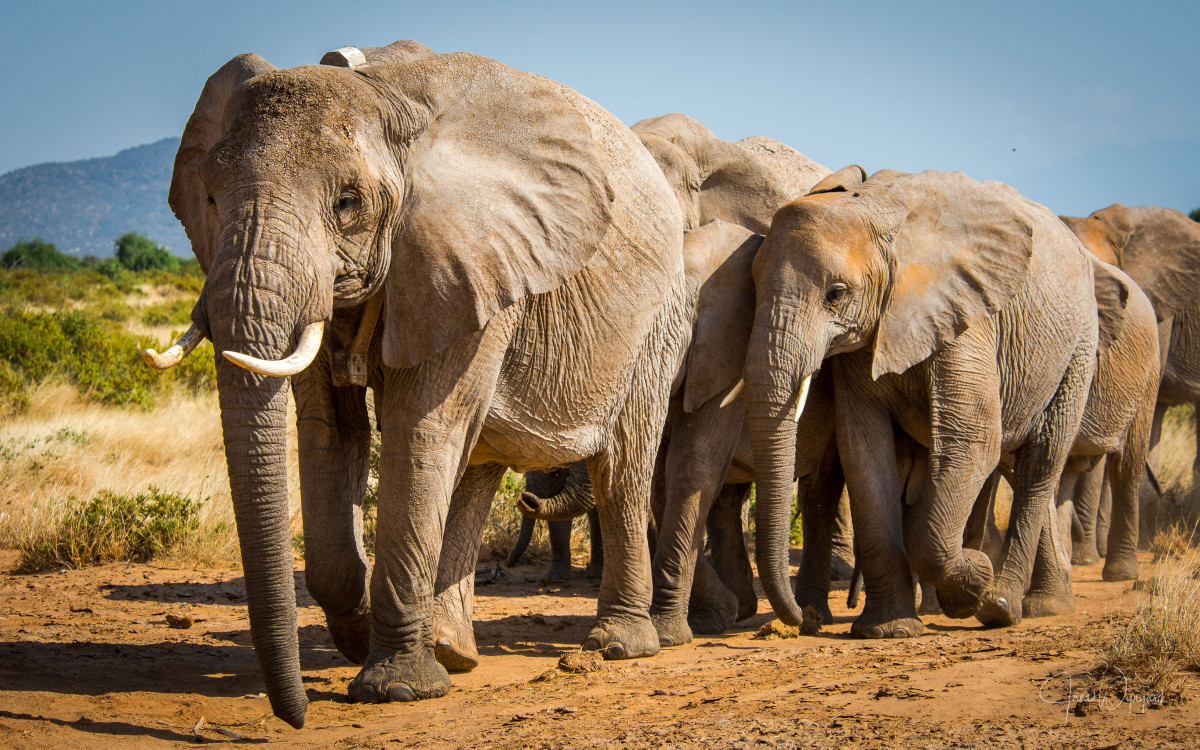
(15) Nile crocodile
Life span:70 years
Weight:1,000 kg
Gestation period: A female lays between 30 to 60 eggs that incubate for 80 to 90 days.
Speed:30-35km/h in water(17km/h on dry land)
-
Gestation period: A single female typically lays a clutch of between 30 and 60 eggs that incubate for 80 and 90 days. Temperatures of the nest during a period of incubation determine the sex of the hatchling crocodiles.
The Nile crocodile is a large crocodilian native to freshwater habitats in Africa, where it is present in 26 countries. Due to its widespread occurrence and stable population trend, It is often said that you can outwit a crocodile by running in a zig-zag fashion away from it. This isn’t true! Humans can out run crocodiles on land, and a straight line is the fastest way of putting distance between yourself and the crocodile.
(16) Zebra:
Lifespan:25 years
Weight:350kg-450k
Speed: 65 km/h
Gestation period: 13 Months
Zebras are African equines with distinctive black-and-white striped coats. There are three extant species: the Grévy’s zebra, plains zebra, and the mountain zebra. Zebras share the genus Equus with horses and asses, the three groups being the only living members ofthe
(17) Giraffe:
Lifespan:26 Years
Speed: 60km/h
Weight: 800kg
Gestation period: 15 Months
The giraffe is an African artiodactyl mammal, the tallest living terrestrial animal and the largest ruminant. It is traditionally considered to be one species, Giraffa camelopardalis, with nine subspecies.Giraffes have slightly elongated forelegs, about 10% longer than their hind legs. The pace of the giraffe is an amble, though when pursued it can run extremely fast, up to 55 km/h. It cannot sustain a lengthy chase. Its leg length compels an unusual gait with the left legs moving together followed by right (similar to pacing) at low speed, and the back legs crossing outside the front at high speed. When hunting adult giraffes, lions try to knock the lanky animal off its feet and pull it down. Giraffes are difficult and dangerous prey. The giraffe defends itself with a powerful kick. A single well-placed kick from an adult giraffe can shatter a lion’s skull or break its spine. Lions are the only predators which pose a serious threat to an adult giraffe.
(18)Springbok
Lifespan: 7-9 years.
Speed: 88 km/h
Weight: 33 to 48 kg
Gestation period: 6months
Description;
The springbok or springbuck is a medium-sized antelope found mainly in south and southwest Africa. The sole member of the genus Antidorcas, this bovid was first described by the German zoologist Eberhard August Wilhelm von Zimmermann in 1780. Three subspecies are identified.
(19) sitatunga
Lifespan: 22 years.
Speed: 88 km/h
Weight: 25 to 80 kg
Gestation period: 8 months
Description;
The sitatunga is an amphibious antelope (meaning it can live on both land and water) confined to swampy and marshy habitats. The sitatunga or marshbuck is a swamp-dwelling medium-sized antelope found throughout central Africa, Sitatungas are one of the most aquatic antelope species and have many adaptations that allow them to spend time in water.
(20) Eland
Lifespan: 15 to 20 years.
Speed: 40 km/h
Weight: 400 to 940 kg
Gestation period: 10 months
Description
The common eland, also known as the southern eland or eland antelope, is a large-sized savannah and plains antelope found in East and Southern Africa. It is a species of the family Bovidae and genus Taurotragus. The eland is the largest African bovid, but the slowest antelope. It can only run about 40 km/h (25 mph), but it can jump 3 m (10 ft.) from a standing start. When walking, tendon or joints in the eland’s foreleg produce a sharp clicking sound, the cause of which has not been widely investigated. As the eland’s habitat is so versatile, so is its diet and includes grasses, seeds, leaves, fruits and herbs. Eland are herbivores and graze mainly on grasses. But they will also eat browse, seeds and fruits.
(21) Rock hyrax
Lifespan: 9 to 12 years.
Speed: 30 km/h
Weight: 2 to 5 kg
Gestation period: 10 months
Description
The rock hyrax, also called dassie, Cape hyrax, rock rabbit, and coney, is a medium-sized terrestrial mammal native to Africa and the Middle East. Commonly referred to in South Africa as the dassie, it is one of the five living species of the order Hyracoidea, and the only one in the genus Procavia. The elephant and the hyrax are both descended from a common ancestor, the tethytheria, who died out some 50 million years ago. The teeth, toes and skull of the hyrax and elephant have similar pachyderm-like characteristics. These herbivores’ favorite foods are plants, berries and flower buds, but their diet also includes several poisonous plants. Amazingly, rock hyrax can eat plants that are too dangerous for other animals to eat because of their hardy three-chambered stomach. Even though they get sufficient moisture from their food, they will drink water if it is available. The social structure of the Rock Hyrax consists of a male and his harem. The harem consists of two to 26 females and their young, depending upon suitable habitat.
(22) Thomson’s gazelle
Lifespan: 10 to 15 years.
Speed: 64 km/h
Weight: 23 to 25 kg
Gestation period: 6 months
Description
Thomson’s gazelle is one of the best known species of gazelles. It is named after explorer Joseph Thomson and is sometimes referred to as a “tommie”. This small gazelle is fast and graceful. It bounces up and down energetically when it is threatened by predators, such as lions, cheetahs, and hyenas. This bouncing is called “stotting” or “pronking.” The Thomson’s gazelle lives in eastern Africa and is the most common gazelle in its region. Gazelles have adapted to inhabit waterless steppe, subdesert, and even desert. They can extract water from the plants they browse without having to drink. They have narrow jaws and incisor rows for highly selective feeding on the most nutritious growth.
(23) Bontebok
Lifespan: 10 to 15 years.
Speed: 64 km/h
Weight: 23 to 25 kg
Gestation period: 6 months
Description
Bontebok’s coat is mostly a rich brown color, their tails, bellies, and feet are white. Bontebok weigh between 120-175 pounds and measure four to five feet in length. Males are slightly larger than females, and both sexes develop angular ringed horns that grow up to 18 inches in length. The bontebok is an antelope found in South Africa, Lesotho and Namibia. D. pygargus has two subspecies; the nominate subspecies, occurring naturally in the Fynbos and Renosterveld areas of the Western Cape, and the blesbok occurring in the Highveld. The bontebok is related to the common tsessebe. Bontebok graze the surface. Bontebok are herbivores and their diet consists of various short grasses and plants. They are considered to be diurnal grazers, which means they will graze during the morning and evening and rest during the heat of the day.
(24)Diki diki
Lifespan: 10 years.
Speed: 42 km/h
Weight: 3 to 6 kg
Gestation period: 6 months
Description
A dik-dik is the name for any of four species of small antelope in the genus Madoqua that live in the bushlands of eastern and southern Africa. Dik-diks stand about 30–40 centimeters at the shoulder, are 50–70 cm long, weigh 3–6 kilograms and can live for up to 10 years
(25) impala
Lifespan: 10 years.
Speed: 75 to 90 km/h
Weight: 40 to 75 kg
Gestation period: 7 to 8 months
Description
The impala is a medium-sized antelope found in eastern and southern Africa. The only extant member of the genus Aepyceros, and tribe Aepycerotini, it was first described to Europeans by German zoologist Hinrich Lichtenstein in 1812. Impalas are fleet runners who are able to leap distances of up to 33 feet. They use this technique to escape predators and sometimes, apparently, simply to amuse themselves. The impala can also clear bushes and other obstacles by soaring some 10 feet in the air.
(26)black-footed cat
Lifespan: 10 years.
Speed: 2 to3 km/h
Weight: 2 kg
Gestation period: 7 to 8 months
Description:
The black-footed cat, also called the small-spotted cat, is the smallest wild cat in Africa, having a head-and-body length of 35–52 cm. Despite its name, only the soles of its feet are black or dark brown. With its bold small spots and stripes on the tawny fur, it is well camouflaged, especially on moonlit night.T he Black-footed Cat Felis nigripes is Africa’s smallest felid, and among the smallest wild cat species in the world. The soft, dense coat ranges from dark to pale tawny gold, with a bold pattern of rounded dark brown to black spots which sometimes merge into bands or rings. Their large eyes are amber or greyish brown. The Black-footed cat is actually the smallest wildcat in Africa and is also an exceptional hunter. Indeed, this cat can kill more prey in a single night than a leopard in six months, making it the deadliest of all the world’s felines.
(27)caracal cat
Lifespan: 10 years.
Speed: 80 km/h
Weight: 8 to 20 kg
Gestation period: 2 months
The caracal is a medium-sized wild cat native to Africa, the Middle East, Central Asia, and arid areas of Pakistan and northwestern India. It is characterized by a robust build, long legs, a short face, long tufted ears, and long canine teeth with amazing jumping abilities, leaping up to 10 feet (3 meters) to swat a flying bird. They can even leap on a sitting ostrich! Caracals keep their claws sharp to help them capture their prey. They sometimes climb trees and even stash their catch in the branches for a later meal. The name Caracal is derived from a Turkish word “karakulak” meaning “black ear.” The Caracal was once trained for bird hunting in Iran and India. They were put into arenas containing a flock of pigeons, and wagers were made as to how many the cat would takedown. Caracals are strictly carnivorous. They prey primarily on birds, rodents and small antelopes. Like most cats, caracals stalk their prey before pouncing on it. In areas of human settlement, these cats sometimes eat poultry.
(28)meerkat
Lifespan: 10 years.
Speed: 80 km/h
Weight: 8 to 20 kg
Gestation period: 2 months
Description;
Active and social animals, meerkats live in groups that can include as many as 30 individuals, although the average pack size is around ten to 15 individuals. Groups are called mobs, and each mob may consist of up to three families living together. Each family group consists of a breeding pair and their offspring.
The meerkat is a small mongoose found in southern Africa. It is characterized by a broad head, large eyes, a pointed snout, long legs, a thin tapering tail, and a brindled coat pattern. The head-and-body length is around 24–35 cm, and the weight is typically between 0.62 and 0.97 kg, these are some of the facts of Meerkats that will amaze you, these animals are immune to venom and are actually pretty tough if you look like lunch , they are highly intelligent, are omnivores and rarely drink water.
(29)Ostrich
Lifespan: 30 to 40 years.
Speed: 70 km/h
Weight: 120 to 140 kg
Gestation period:35 to 45 days
Description
Ostriches are large flightless birds. They are the heaviest living birds, and lay the largest eggs of any living land animal. With the ability to run at 70 km/h, they are the fastest birds on land. Ostriches are omnivores, and they eat whatever is available in their habitat at that time of the year. They mostly eat plants, especially roots, leaves, and seeds, but they also munch on insects, snakes, lizards, or rodents that come within reach. Generally, females will lay an egg every other day. If the eggs are taken from the nest daily, the hen may lay up to 80 eggs, although 40-to-50 is more typical. An inadequate diet may result in less egg production. Ostrich eggs are the largest of all eggs and weigh about 2.75 pounds. However, ostriches may turn aggressive rather than run when threatened, especially when cornered, and may also attack when they feel the need to defend their offspring or territories.
(30)Aardvark

